Other
Explorers Elgar Road’s Secret? Invested Leaders, Thanks to Your Share
When your Centre Director cares like it’s their own, your child gets the care they deserve. Here’s how the Explorers Your Share program enhances the quality-of-care families and children receive at Explorers Surrey Hills – Elgar Road.
There’s no greater responsibility than caring for children, and no greater honour than being trusted by families to do so. At Explorers Early Learning, we don’t just talk about valuing our people, we show it. And in doing so, we raise the bar for early education in Australia.
At Explorers Early Learning, we’re proud to be pioneers, not just in the way we educate and care for children, but in how we invest in the passionate leaders who run our centres.
Enter the Explorers Your Share program, an initiative that is doing something no other early learning provider in Australia promotes – giving Centre Directors the chance to become part-owners in the centres they lead.
Explorers Surrey Hills – Elgar Road Centre Director Nadia joined the Your Share program in March 2025. She has over 20 years of experience working in early childhood education, including a master’s degree in teaching.
After first joining Explorers as a Regional Manager, Nadia then moved into the Director role at our Surrey Hills – Elgar Road centre, a position she believes to be a true reflection of her passion and values.
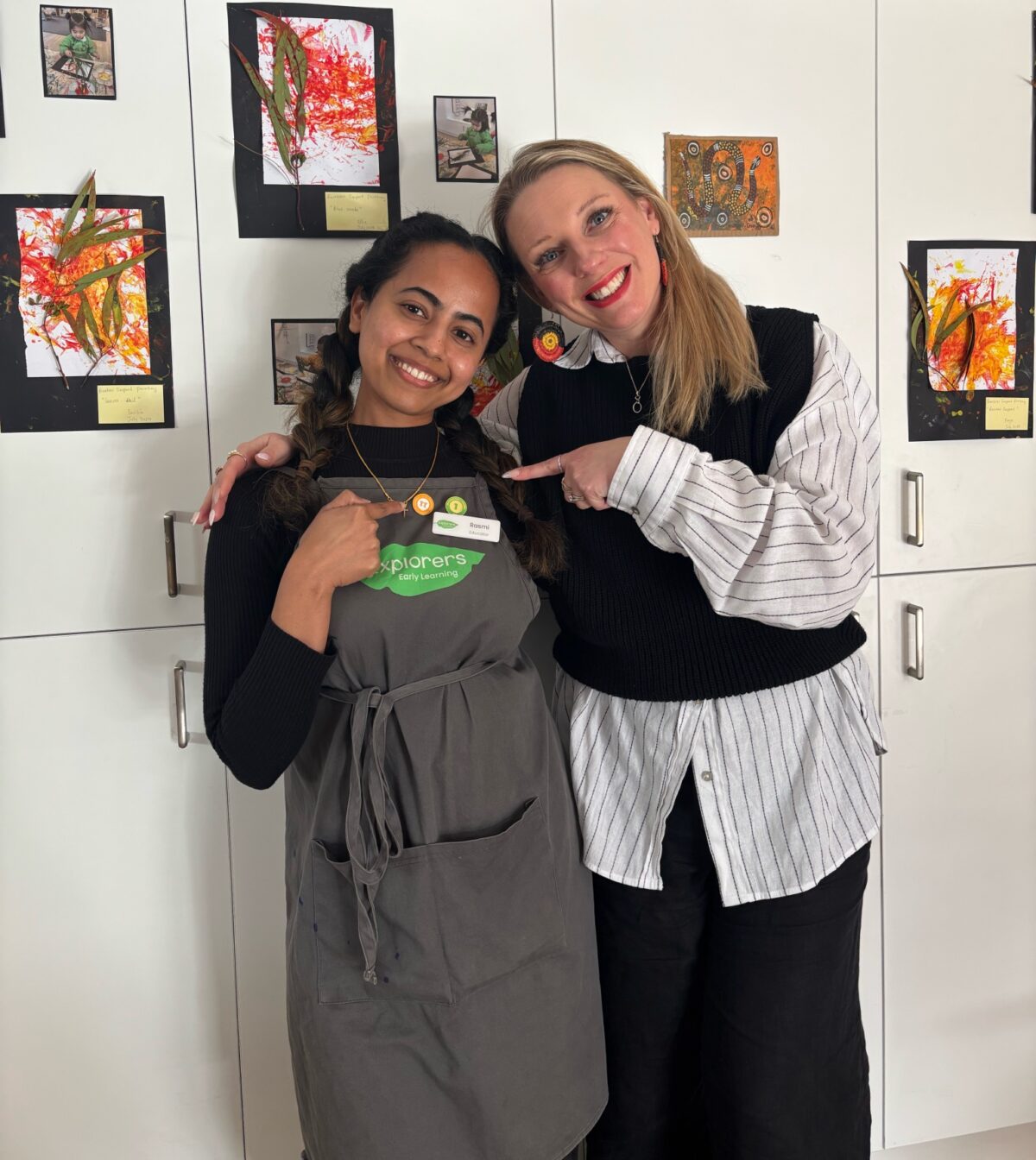
To be acknowledged by Explorers for her incredible work and to be given the opportunity to become part of the bigger picture at Explorers is not lost on Nadia.
“It felt incredibly empowering to be recognised,” she says. “Having our senior leaders see leadership potential in me and back me so openly was humbling. Their belief inspired me to take the leap.”
Leadership You Can Feel: The Difference at Explorers Elgar Road
Families often speak about the importance of consistency and familiarity. A stable, long-term Centre Director means fewer transitions, fewer disruptions, and a deeper understanding of your child’s individual needs over time.
As a parent, knowing that the person responsible for your child’s wellbeing is more than just a fleeting face is something we at Explorers take seriously, and the Your Share program helps ensure consistency.
Centre Directors at Explorers Early Learning are supported by a range of factors that encourage long-term commitment. This includes the opportunity to hold shares in their centre, which further strengthens their connection and investment in its success.
Families at centres participating in the Your Share program are already experiencing the highest standards in education and care. Now, those standards are driven even higher by the personal investment of the Director. Since becoming a shareholder, Nadia says the program has brought a new dimension to her role. One of deeper connection, vision, and responsibility.
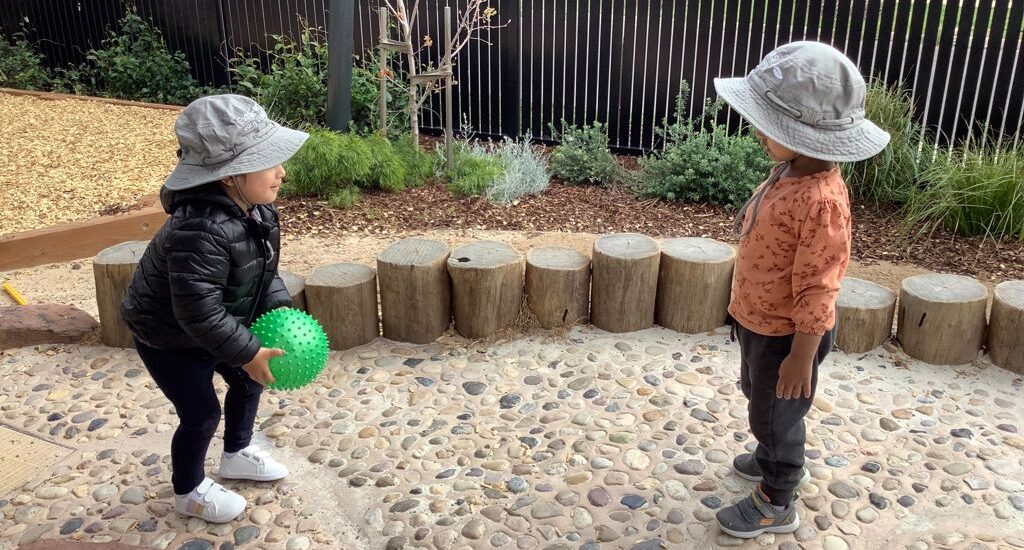
“The formal expectations of my job haven’t changed, but I feel more personally invested in our performance and culture,” she explains. “You naturally start to think more strategically, how every decision impacts our long-term success.”
At Explorers Surrey Hills – Elgar Road, this has translated into a centre that thrives on innovation, care, and strong community ties.
“There’s a shared energy here,” Nadia says. “The team knows we’re building something meaningful together. Being a shareholder reinforces that, I’m not just leading the centre, I’m growing with it.”
Explorers Your Share uplifts quality for children & families at Elgar Road
Explorers Early Learning continues to set the benchmark in early childhood education, not only through our Learning for Life Curriculum and beautifully designed spaces, but through its commitment to growing the people who lead its centres.
The Your Share initiative also brings visibility. “Other centres look to us as an example,” Nadia acknowledges. “That adds a layer of accountability. But it’s also inspiring. I want to be someone others can turn to for guidance and support.”
For families considering Explorers Elgar Road – Surrey Hills for their children, Nadia believes the benefits of the program trickle down to the very heart of what matters most: the children.
“When leadership is strong, invested, and passionate, everything flows from there. Our families know we’re not just here to manage – we’re here to lead with heart and purpose.”

The Your Share program isn’t just about rewarding high performance; it’s about ensuring deep alignment with the Explorers way. Every shareholder Director has proven their dedication to our values that include Ownership and Relationships.
“Ownership is more than just being responsible,” adds Nadia. “It’s about taking pride in everything that happens within those walls, from how clean the rooms are to how supported the Educators feel.”
With the Your Share initiative, families can be confident their centre is led by someone who is deeply invested in providing the very best for their child. When your Centre Director cares like it’s their own, your child gets the care they deserve.
To tour Explorers Surrey Hills – Elgar Road or one of our other beautiful centres, please click here. Otherwise, check out our website to register your interest at Explorers Early Learning today!
Learning Together: Kerrie O’Neill Inspires at Explorers Nunawading
Kerrie O’Neill’s presence at Explorers Early Learning Nunawading, through coaching and mentoring, has uplifted Educators practice, creating meaningful enhancements and excitement in the process.
With nearly four decades of experience in early learning and childhood education, Kerrie is a deeply respected voice in the sector. Known not only for her practical expertise but also for her unwavering passion. At Explorers Early Learning, her presence is both inspirational and transformative, anchoring the organisation’s commitment to participatory education inspired by the Reggio Emilia Approach®.
A turning point in Kerrie’s career came in the mid-1990s when she was first introduced to the Educational Project of Reggio Emilia. This educational approach would come to define much of her professional journey.
“I first went to Reggio in 1996, but I was introduced to the ideas in 1994,” she explains. Since then, she has returned to the Italian city 15 times over 30 years, a testament to her commitment to deeply understanding and authentically experimenting with Reggio-inspired practices in the Australian context.
Kerrie’s deep connection to Reggio Emilia is both theoretical and practical. At Explorers Early Learning, our centres take inspiration from the Reggio principles and values. As an expert, Kerrie works as a mentor and coach for Educators, helping them implement the Explorers curriculum with intention and authenticity.
Currently, Kerrie is playing a vital role at Explorers Early Learning as the Pedagogical Thinker in Residence.
“Through the coaching and mentoring process, I’m trying to encourage Educators to challenge the dominant discourse,” she says. “The things that they’ve been told by other people…I try and have a conversation with them about why they are doing what they’re doing.”
Her Journey at Explorers Nunawading
Throughout June and July, Kerrie has been a regular and welcome presence at Explorers Early Learning Nunawading, working at the centre three days a week to mentor educators and enhance the environments to inspire even greater engagement amongst the children.
“The intent was for me to come in and uplift Educators’ practice.”
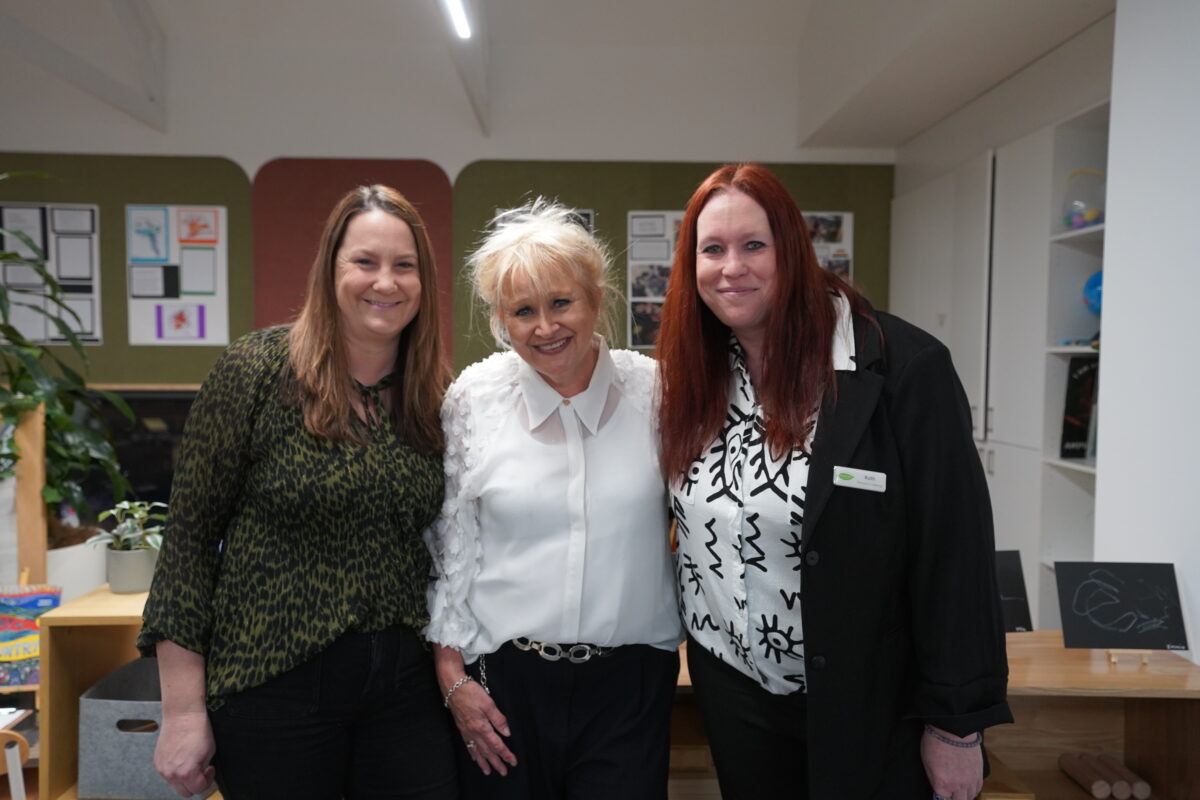
Explorers Nunawading offers a unique and hands-on experience for children. Utilising the Reggio Emilia Approach and applying these concepts in the Explorers Learning for Life Curriculum, our Nunawading centre provides children with the opportunity to:
- Connect with nature through the Bush Kinder program
- Learn and create with our unique Visual Arts Program
- Experience joy
- Participate in play-based learning
Kerrie has brought expertise and practical thinking to support the Educators and leaders in enriching children’s learning experiences. She’s been instrumental in enhancing learning environments through critical reflection processes.
“It’s really important for children to have as many experiences with materials during the day as possible,” Kerrie says. “That includes mark-making materials (such as paintbrushes and pencils), recycled materials, dress-up, blocks and many more.”
Inspiring Explorers Educators to dive deeper
Kerrie’s coaching and mentoring encourages Educators to critically reflect on everything they do so they don’t teach out of habit, they teach with intentionality.
“If they’re only doing it because someone else told them to do it, that’s not good enough,” Kerrie begins. “I’m really encouraging them all to say, why are we doing it this way?”
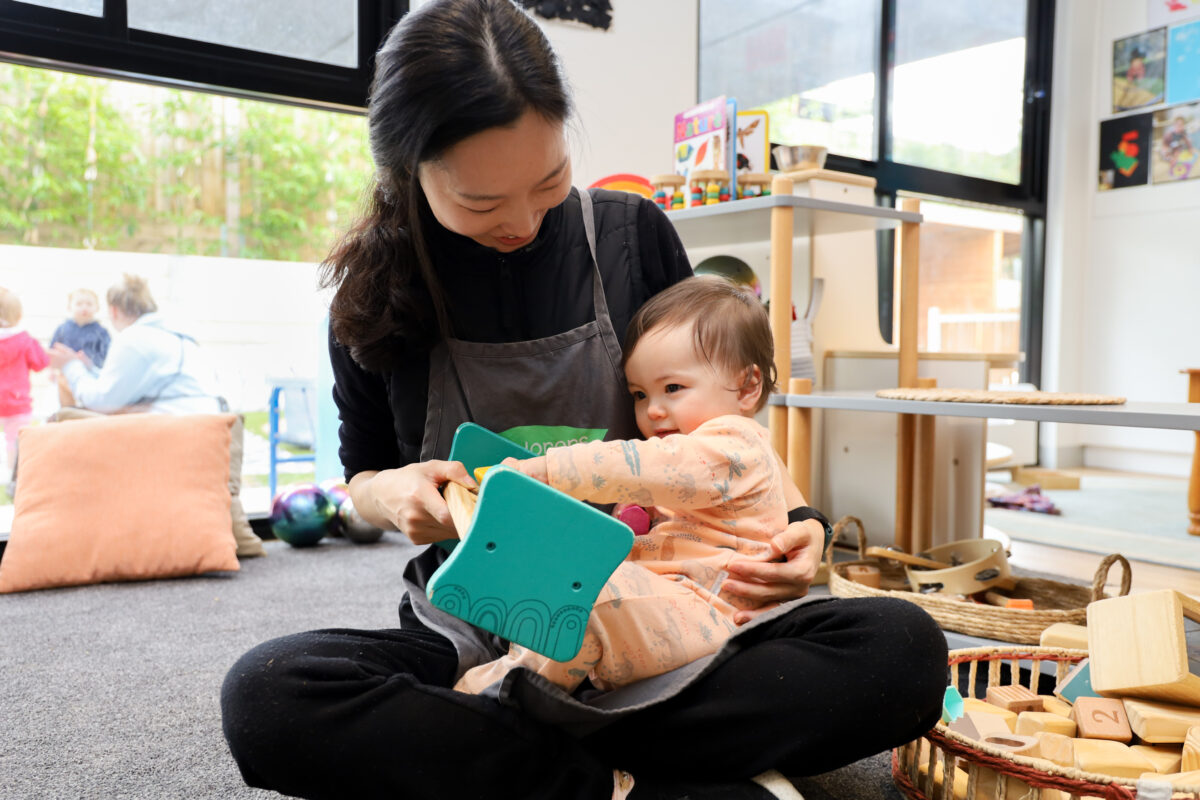
By working closely with all the teams, Kerrie’s impact will be long-lasting. Through coaching and collaboration, she has built capacity within the team so they can confidently continue to deliver high-quality education and consistent care to each and every child at Explorers Nunawading.
Her ongoing mission is to ensure that early childhood Educators remain reflective, intentional, and inspired. Through her Reggio-informed lens and her decades of practical experience, she empowers Educators to see children as active participants in their own learning.
Her presence at Explorers Nunawading highlights the value of expert mentorship and thoughtfully designed environments in early childhood education, making a lasting difference in both teaching practices and children’s learning.
Kerrie is proud to witness the Explorers Nunawading team’s newfound passion and excitement and amongst the Educators, families and children.
Early Childhood Education is not just about getting children ready for school. Rather, it’s about making sure that they are equipped for the challenges of formal schooling and leave Explorers confident and enthusiastic.
To tour Explorers Nunawading or one of our other beautiful centres, please click here. Otherwise, check out our website to register your interest at Explorers Early Learning today!
Fuel for Life: Elevating Nutrition and Development from Birth
Providing children with the right nutrition from birth is vital for development and growth. But what does it even look like at that age? Continue reading for our full breakdown.👇
Did you know that the early years of a child’s life lay the foundations for lifelong health and development? Eating patterns are established from the minute a child is born and continue all the way into adulthood.
As such, providing a child with balanced sustenance from birth supports their development and sets them up for joyful eating as toddlers and as they enter adulthood.
However, raising a young child and providing them with the right nutrition to encourage development is no easy feat.
Given this, we’ve broken down everything you need to know about elevating nutrition for your child.
Why is Nutrition Important for Development?
Research consistently supports the critical role nutrition plays in a child’s growth, particularly during the first 1,000 days – from conception to a child’s second birthday.
This is an important window for establish thing healthy eating habits that support cognitive and physical development.
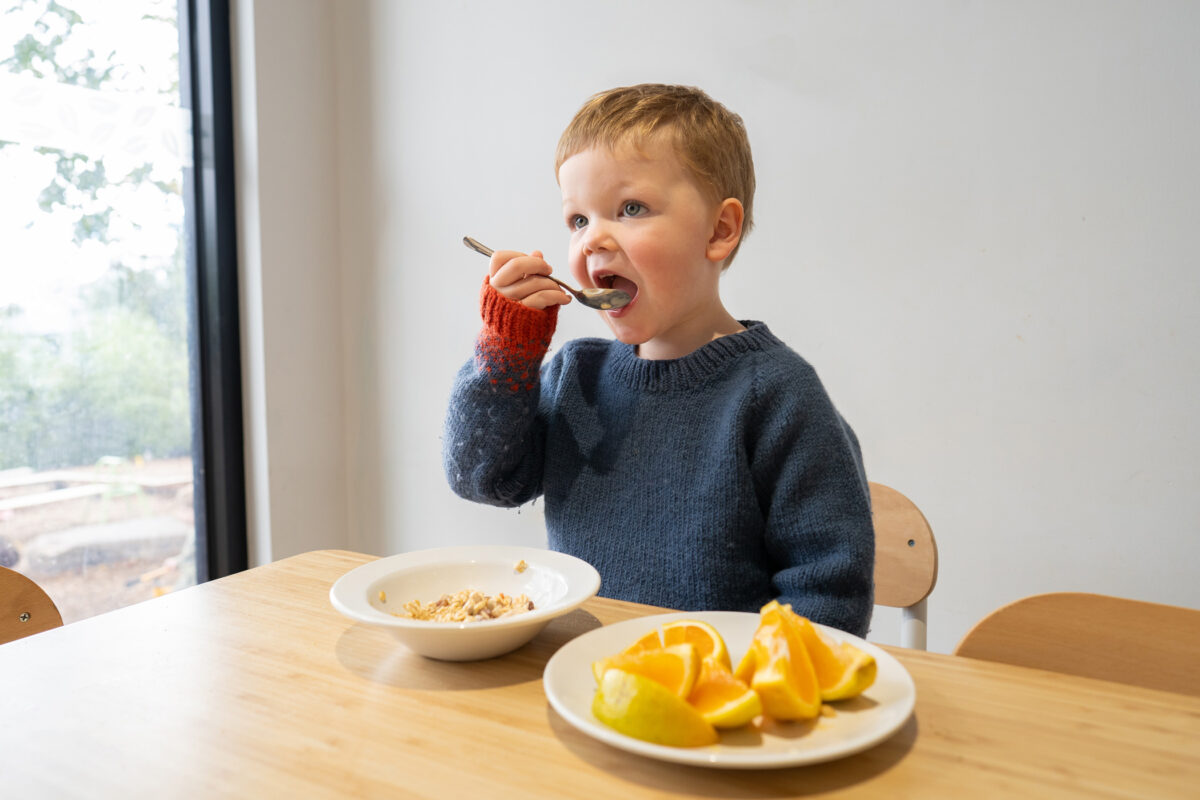
During this period, a child’s brain, body and immune system develop significantly more than any other stage of their life. Throughout this time of swift growth, providing children with the right nutrition is vital to support their overall development.
A research paper published by the Centre for Community Health at The Royal Children’s Hospital, Melbourne, outlines how satisfactory nutrition reduces the risk that a child will develop health complications later in life.
Health difficulties that have a greater chance to arise when a child’s nutritional needs are not met includes:
- Asthma
- Type-2 diabetes
- Coronary heart disease
- Osteoporosis
- Lung disease
- Allergies
What Does Good Nutrition Look Like During the First 1,000 Days?
During the first six-months of a child’s life, breastmilk and formula contain the bulk of nutrients required to optimise growth and reduce allergy rates, an expanding health issue and concern throughout Australia.
Once the six-month mark is reached, children then need additional nutrition to further support their maturation. Fibre, vitamins and minerals are amongst the most important nutrients for infants and their development.
These can be best found in:
- Fruits
- Vegetables
- Meat (or alternatives)
- Diary
- Grains
The introduction of solid foods opens your child up to a whole new world of textures, smells and of course, tastes. As such, it’s important to be patient as your baby begins to adapt to their new, varied diet and explore different types of nutrition.
If you have any concerns about you baby’s eating habits during this important period of growth and development, it’s important to consult your GP or paediatrician regarding specific dietary needs, allergens, or intolerances.
While providing the right type of nourishment for a child is important, so too is ensuring that unhealthy foods, or those that contain high levels of salt and sugar, are avoided.
Nutrition at Explorers
Given the integral role nutrition plays in the growth and development of children, particularly during the first 1,000 days, it is now a requirement in Australia that early childhood services actively promote healthy eating and physical activity as part of their programs.
At Explorers Early Learning, we pride ourselves on not just meeting these nation-wide standards but in going the extra mile to provide a variety of delicious and nutritious seasonal food for children to support their development.
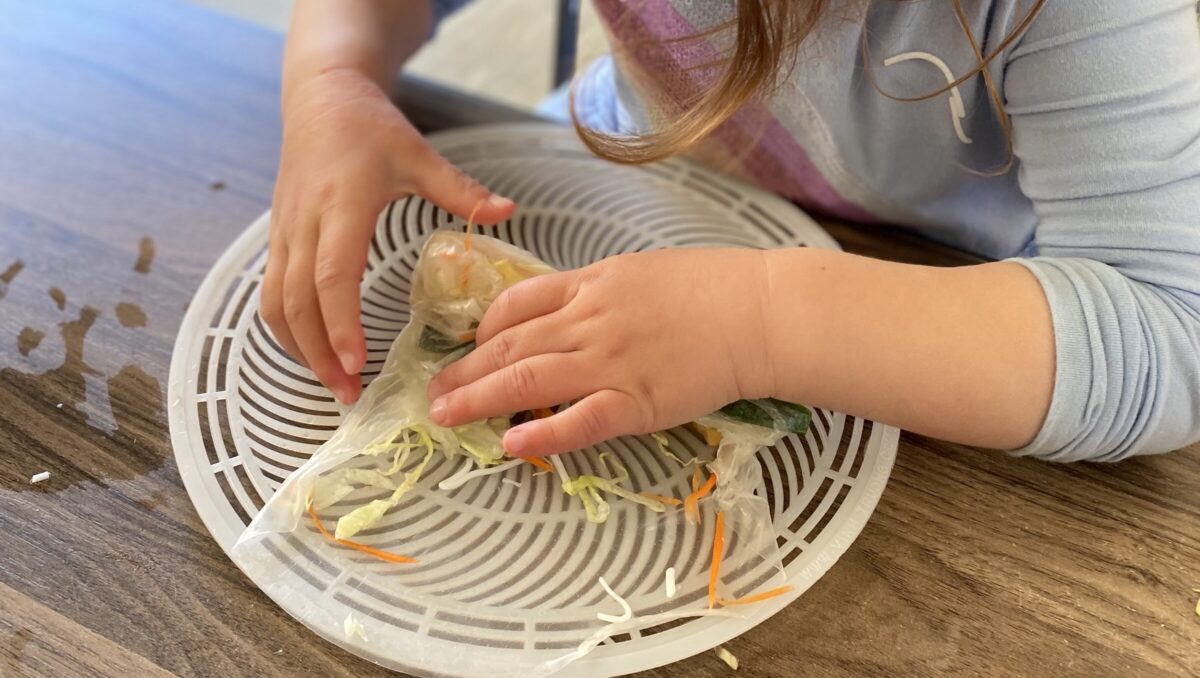
We cater to a range of allergies and intolerances, ensuring that every child’s dietary needs are met thanks to our joyful menu that has been approved by Nutrition Australia.
Our partnership with award-winning chef, Karen Martini, will help us innovate and stretch our thinking when it comes to mealtimes and ensure all children at Explorers are provided the nutrition they need for their cognitive and physical growth.
🍃 To tour one of our beautiful Centres, please click here. Otherwise, check out our website to register your interest at Explorers Early Learning today!
Child Care Subsidy (CCS) Explained
Big changes have been made to the Child Care Subsidy, making childcare more affordable that ever before. Here’s a breakdown of the CCS updates and what they mean for your budget.
Enrolling your child into early learning and childcare can be stressful for parents, so government subsidies are often the last thing on your mind.
Family structure and dynamics across Australia continue to evolve, with more parents relying on a dual-income to combat cost of living rises. As such, the need for early learning education and childcare services has never been more prevalent.
However, the Child Care Subsidy (CCS) is a Federal Government subsidy you should know about. The CCS cuts out a large part of your childcare fees which will result in significant savings for families in the cost of childcare.
The Australian Government’s new 3 Day Guarantee Childcare scheme will make Early Learning more accessible and affordable than ever before!
What’s more, the Federal Government will remove the ‘Activity Test’, a huge obstacle Australian families face when seeking childcare subsidy (CCS) for their children.
Here’s everything you need to know.
How Does the Current CCS Payment Work?
Currently, the Federal Government assists families with childcare payments in the form of the CCS. This payment is made directly to childcare providers, like Explorers, who then pass it on to families as a fee reduction.
These payments scales depending on your combined family income. Notably, the family income threshold to be eligible for the maximum amount of Child Care Subsidy increased on July 7, 2025.
The current scale in place for CCS is included below:
| Family Income | Child Care Subsidy % |
| $0 – $85,279 | 90% |
| More than $85,279 to below $535,279 | Between 90% and 0% – The percentage decreases by 1% for every $5,000 of income a family earns |
| $535,279 or more | 0% |
On top of these changes, the Australia Government is also rolling out a brand new childcare scheme at the beginning of 2026.
This new game-changing initiative will guarantee families access to 3 full days of childcare (36 hours) each week (72 hours per fortnight) and make early learning more accessible than ever.
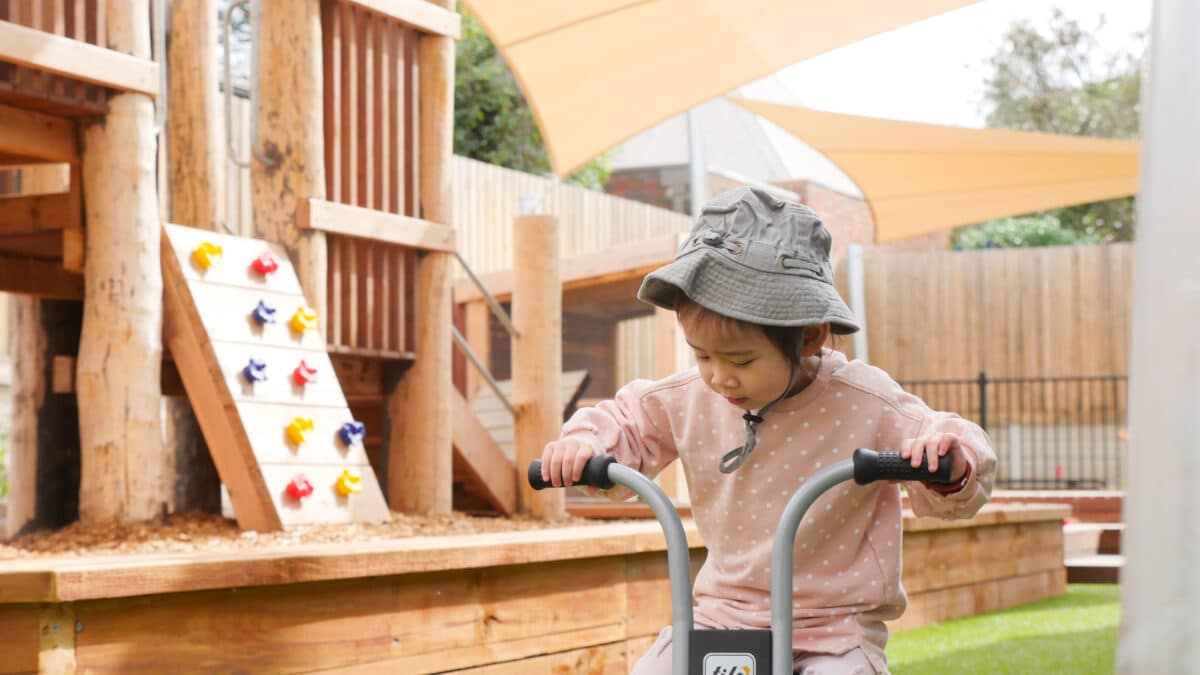
3 Day Guarantee Subsidy Explained
To assist families further, the Australian Government are investing $426.7 million over the next five years to guarantee eligible families at least 3 days of subsidised childcare (CCS).
The 3-day guarantee will kick into effect from 5 January, 2026.
It’s important for families to understand what this means in practice. The 36-hour allowance per week translates to three full days of care per week that are covered by the subsidy.
As outlined by the Department of Education, the aim of the 3 Day Guarantee is to “support universal access” to childcare and early learning education, “ensure more children are school-ready” and finally, “provide targeted cost-of-living relief to families.”
This subsidy will make the early learning sector more affordable and accessible for parents, reducing financial strain and encouraging flexibility for key demographics that include but are not limited to:
- Working parents
- Single parents
- First-time parents
- Low-income families
Furthermore, First Nations families will now have access to 100 hours of subsidised care per fortnight – a substantial increase from the previous minimum of 36 hours each fortnight.
Who is eligible?
In Australia, every family that earns less than $533,280 per year will be eligible for the 3 Day Guarantee. Families earning above this threshold will not be able to access the subsidy.
The Australian Government has estimated that in its first full financial year, over 66,000 families will be benefit from the 3 Day Guarantee.
What’s more, over 100,000 families will also be eligible for additional hours of subsidised care, granting greater flexibility when exploring childcare and early learning services in the process.
How much money will families save?
The Government fact sheet published alongside the announcement of the subsidy outlines how much families can expect to save.
This estimate has been created based on the following parameters:
- One child in care for 36 hours per week (three full days).
- 50 weeks of care per year.
- Average Centre-Based Day Care hourly fees for 2025–26.
- Rounded savings estimates for clarity.
| Annual Household Income | Savings Per Week | Savings Per Year (50 weeks of care) |
| $90,000 | $230 | $11,400 |
| $120,000 | $220 | $10,630 |
| $140,000 | $200 | $10,110 |
For example, a couple with a combined family income of $90,000 per annum were previously only eligible for 18 hours of subsidised ECEC per week. Starting in January 2026, they will now have access to 36 hours per week (72 hours per fortnight) under the 3 Day Guarantee scheme.
The amount each family can save varies depending on a range of factors, such as:
- Family income threshold
- Hourly fee of their chosen Childcare centre
- Number of days childcare services are utilised
Activity Level Test for CCS Removed
Starting January 2026, the Activity Test will no longer be a barrier for families who have previously not qualified for CCS via the old calculator.
The activity test, first introduced in 2018, required a parent to work, study or volunteer to qualify for childcare subsidies. An estimated 126,000 children, many of whom come from low-income families, have been unable to access childcare and early learning education because their parents failed the activity test.
In particular, the removal of the Activity Level Test will ensure that access to childcare is not compromised, even when:
- Parents are on maternity or paternity leave
- Carers are in between jobs or looking for work
- Following redundancy or reduction of work hours
This is fantastic step forward in making these services available to all Australian families, particularly those from low socio-economic backgrounds.

Explorers and the CCS
At Explorers Early Learning, we provide the best quality childcare and early learning education. Through our Reggio-Emilia inspired approach, all our centres encourage curiosity, spark excitement in learning and support families and children along the journey.
To qualify for the CSS, you must have a MyGov account and complete a CCS assessment. Additionally, your MyGov account must be linked to Centrelink to qualify for, and receive, the CCS.
You can register for a MyGov account here.
As mentioned previously, the CCS is paid directly to the Centre and is based on your child’s attendance records. The gap between the Centre’s daily charge and the CCS will be payable by the family via direct debit.
If you already receive CCS, these changes will automatically come into effect as of 7 July 2025. You don’t need to do anything, just make sure your family income estimates are accurate and to regularly update them if your circumstances change.
For more information on the changes to the CCS, please visit the Department of Education website for an in-depth factsheet. Otherwise, you can always contact our Family Support Team at 1300 000 335 or visit our Family Support Portal.
🍃 Families looking to utilise the 3 Day Guarantee subsidy to increase their days with Explorers – or begin their childcare journey – book a tour at one of our centres or visit our website to learn more.
An Explorers Guide: Babyproofing
Have you got a bundle of joy on the way? If so, read on for our comprehensive checklist so you can babyproof every nook and cranny! 👶
Whether you’re nesting in a house, apartment, or flat, one thing remains constant – babyproofing is non-negotiable. As you eagerly anticipate the arrival of your new bundle of joy, it’s crucial to ensure that every nook and cranny of your home is safe and secure.
But with all the cabinets, doors, and toys scattered around, it’s easy to feel overwhelmed. In this comprehensive post, we’ve got you covered with a detailed room-by-room guide on how to safeguard your home.
What is Babyproofing?
Babyproofing – or childproofing – is the process of making your home as safe as possible for newborns infants and young children. Once babies start crawling at around 7 to 12 month mark, their curious little fingers will fumble for cabinets, bottles, and practically anything you have lying around the house.
Therefore, it’s vital to take proactive measures to minimise potential hazards and create a secure environment. Babyproofing encompasses various strategies and products designed to prevent accidents and injuries, allowing both you and your baby to feel safe and comfortable at home.
How do I Babyproof my Kitchen?
The kitchen, with its bustling activity, enticing aromas, and abundant noise, often becomes a magnet for infants. However, it also harbours numerous potential hazards. Here are a few ways to safeguard your kitchen:
- Cabinet Locks and Latches: Install magnetic locks or latches on cabinets and drawers containing cleaning supplies, sharp objects, or potentially harmful items.
- Stove Guards and Knobs: Consider installing a stove guard or stove knobs to prevent your child from reaching hot surfaces or pulling down pots and pans.
- Appliance Safety: Secure appliances such as fridges, ovens, and dishwashers to prevent tipping. Additionally, keep cords out of reach!
- Keep Toxins High Up: While safety locks and magnetic seals are a great way to keep hazards safe, the best protection is to keep them out of reach. Consider storing all toxins (cleaning products etc) in shelves above the stove, fridge, or anywhere babies and toddlers can’t reach.
- Consider a Baby/Toddler Accessible Drawer: Fill with safe-to-play-with items such as plastic containers and wooden or plastic utensils.
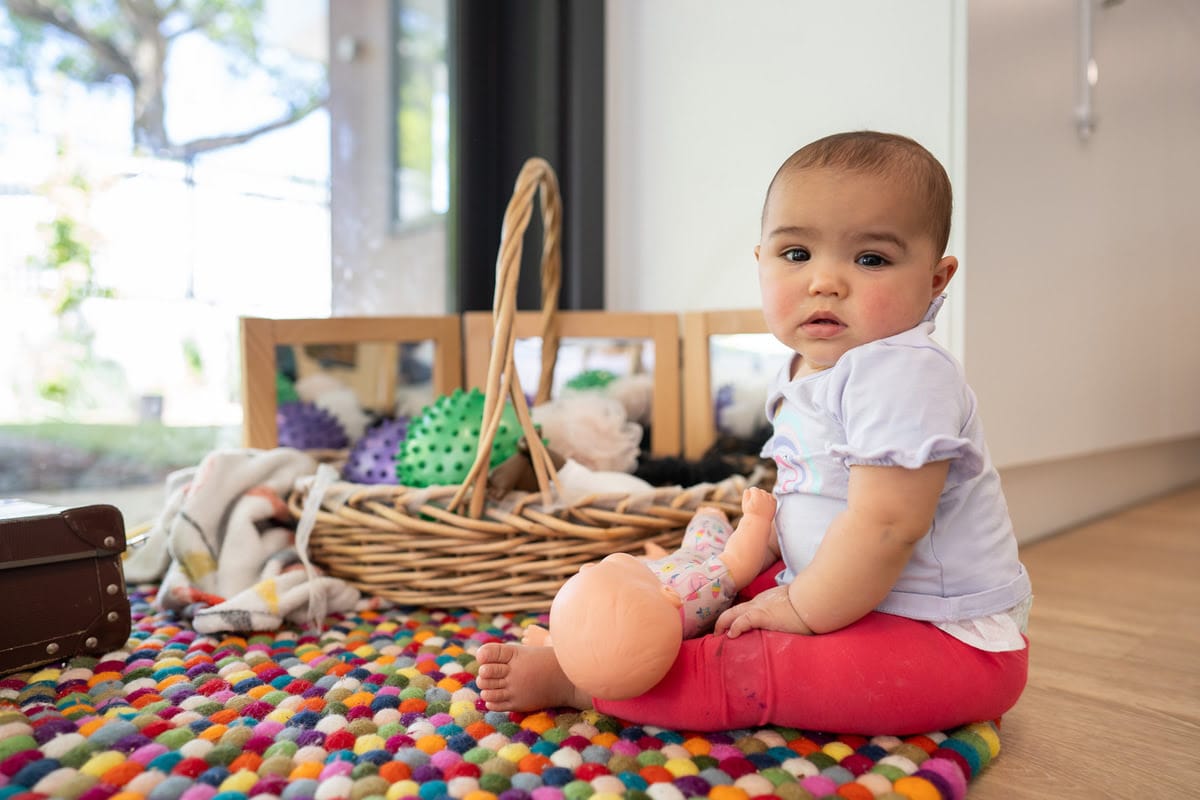
How do I Babyproof my Living Room?
The living room is where your baby is most likely to spend the days rolling, crawling and climbing. Therefore, its essential to ensure this area for play and exploration is also one of safety. Safeguard your living room by incorporating:
- Edge and Corner Guards: Cover sharp edges of furniture with cushioned edge guards to protect against bumps and bruises.
- Secure Furniture: Anchor heavy furniture such as bookshelves, TV stands, and coffee tables to the wall to prevent tipping.
- Cord Management: Keep cords for the tv, electronics, and lamps out of reach or use cord organisers to bundle and secure them safely. Electrical outlet covers are a must!
- Gates and Barriers: Install safety gates to block off stairs or restrict access to certain areas of the room.
How do I Babyproof my Bathroom and Laundry?
The bathroom and laundry can be a hazardous area due to slippery surfaces and potential access to harmful substances. Here’s how to make it safer:
- Lock Away Toxins: Store medications, cleaning products, and toiletries out of reach in locked cabinets or drawers.
- Non-Slip Mats: Place non-slip mats in the bathtub and on the floor to prevent slips and falls.
- Water Temperature Control: Set the water heater temperature to between 37°C and 38°C or lower to avoid scalding in the bath. Remember – babies and young children should never be left unattended around water.
- Secure Toilet Lid Locks: Install toilet lid locks to prevent drowning hazards and keep curious hands out of the toilet bowl.
How do I Babyproof my Backyard and Garage?
Babyproofing your backyard and garage is essential to create a safe environment for your little one to explore without the worry. Just be sure to supervise your baby outdoors at all times:
- Secure gates and fences: Ensure that gates are properly latched, and fences are in good repair to prevent your child from wandering into unsafe areas or leaving the backyard unattended. Fences are especially important if you have a pool and in Australia it’s a legal requirement for pools to be fenced!
- Remove small objects, sharp tools, and hazardous chemicals: Thoroughly inspect the backyard and garage, removing any items that could pose a choking hazard, cause injury, or be harmful if ingested.
- Install safety locks on garage cabinets: Use childproof locks or latches on cabinets containing tools, cleaning supplies, or other potentially dangerous items.
- Ensure outdoor play equipment is age-appropriate: Check that swings, slides, and other play structures are suitable for your child’s age and developmental stage. Ensure they are securely anchored and free from sharp edges or loose parts that could cause injury.
- Inspect the flora and fauna: Regularly walk through your backyard and garage to identify potentially toxic plants, mushrooms, or insect hives (such as ants or wasps).
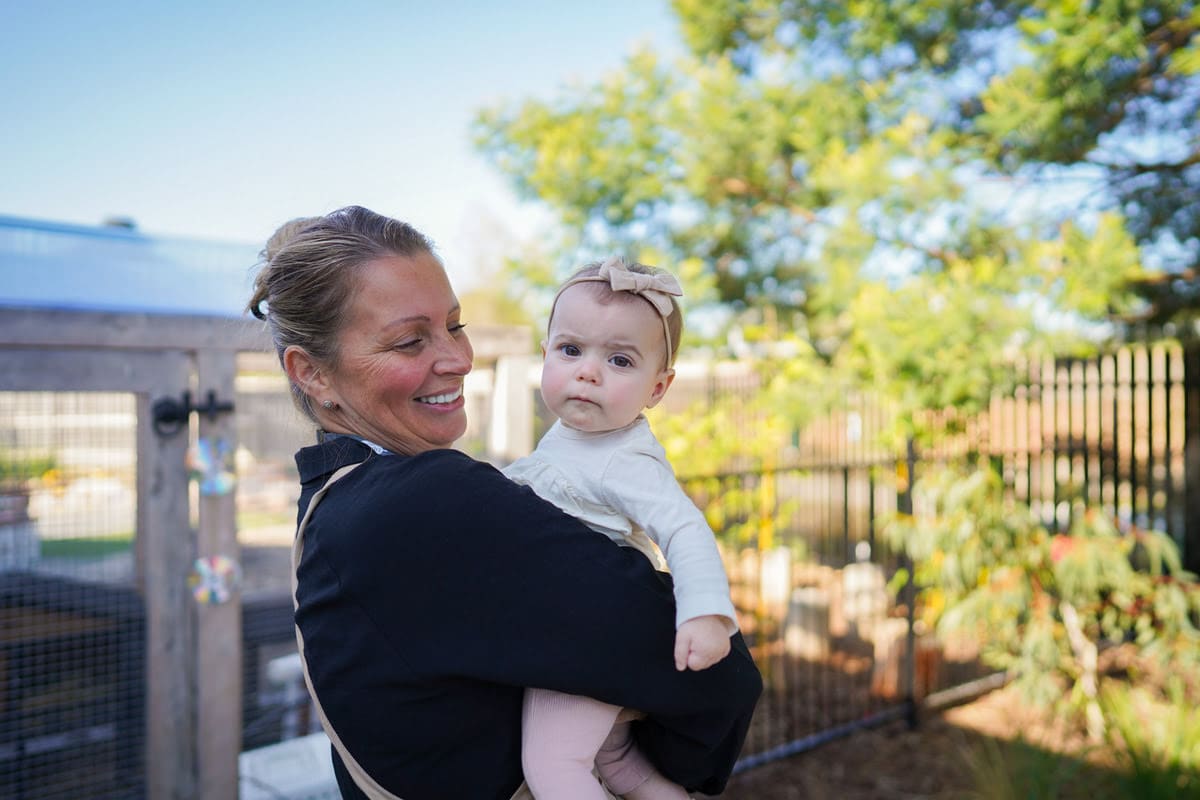
Double-Check the Nursery
Even though the nursery is designed with your baby’s safety in mind, it’s essential to double-check for any potential hazards:
- Cot Safety: Ensure crib slats are spaced no more than 6cm apart to prevent entrapment. Remove any soft or loose bedding, pillows, or stuffed animals from the cot or bassinet to reduce the risk of suffocation.
- Secure Furniture: Anchor dressers, changing tables, and other furniture to the wall to prevent tipping.
- Window Safety: Install window guards or window stops to prevent falls. Keep cords from blinds or curtains out of reach or secured to the wall.
- Electrical Outlet Covers: Use outlet covers to prevent electrical shocks or injuries from curious fingers.
By following these room-by-room babyproofing tips, you can create a safe and secure environment for your baby to explore and grow. Remember, every child is unique, so regularly reassess your home for new hazards as your baby develops and becomes more mobile. With a bit of preparation and foresight, you can enjoy peace of mind knowing that your home is a safe haven for your new bundle of joy.
🍃 To tour one of our beautiful Centres, please click here. Otherwise, check out our website at Explorers Early Learning today!
Explorers Kitchen – Hearty Beef and Vegetable Bolognese
Quick, healthy, tasty. Looking for an easy family dinner? Check out our classic beef bolognese and veggie pasta recipe below 🍝 👇
Is it your turn to cook family dinner? When in doubt, reach for a trusty classic – bolognese! Elevate your dinner with our hearty beef and vegetable pasta, a dish which binds savoury beef, colourful veggies, and aromatic herbs.
And this family-friendly recipe isn’t just tasty, but it also packs plenty of protein for growing bodies and minds.
Prep time: 5 minutes
Cooking time: 20 minutes
Total time: 25 minutes
Serves: 4-6
Ingredients
- 1.5kg beef mince
- 1L vegetable stock
- 400g-500g dry pasta of your choice
- 4 cans diced tomatoes
- 3 red capsicums, diced
- 2 brown onions, diced
- 1 large carrot, diced
- 1 celery, diced
- 3 tablespoons tomato paste
- 2 tablespoons dried Basil
- 2 tablespoons dried oregano
- 2 tablespoons minced Garlic
- 1 tablespoon dried Indigenous bush tomato
- Parmesan cheese (for serving)
- Vegetable oil
Method
- Boil the Pasta: Begin by bringing a large pot of water to a boil and cooking the pasta until Al Dente. Drain and set aside.
- Sauté Garlic: In another pot over medium heat, add vegetable oil and minced garlic. Sauté until the garlic turns a golden brown.
- Cook the Mince: Add the beef mince to the pot, cooking until brown. Then, introduce the diced brown onions, carrot, celery, and red capsicums. Continue cooking until the vegetables tender and brown.
- Add the Herbs: Sprinkle in the dried basil, dried oregano, and the a touch of dried Indigenous bush tomato. This herbaceous trio enhances the flavours, creating a robust and aromatic sauce.
- Make the Sauce: Pour in the vegetable stock, diced tomatoes, and tomato paste. Bring the mixture to a boil and then let it simmer for 30 minutes or until the liquid has reduced.
- Serve: Dish out the hearty beef and vegetable pasta onto plates, serving it alongside the cooked pasta. For an authentic touch, offer parmesan cheese on the side.
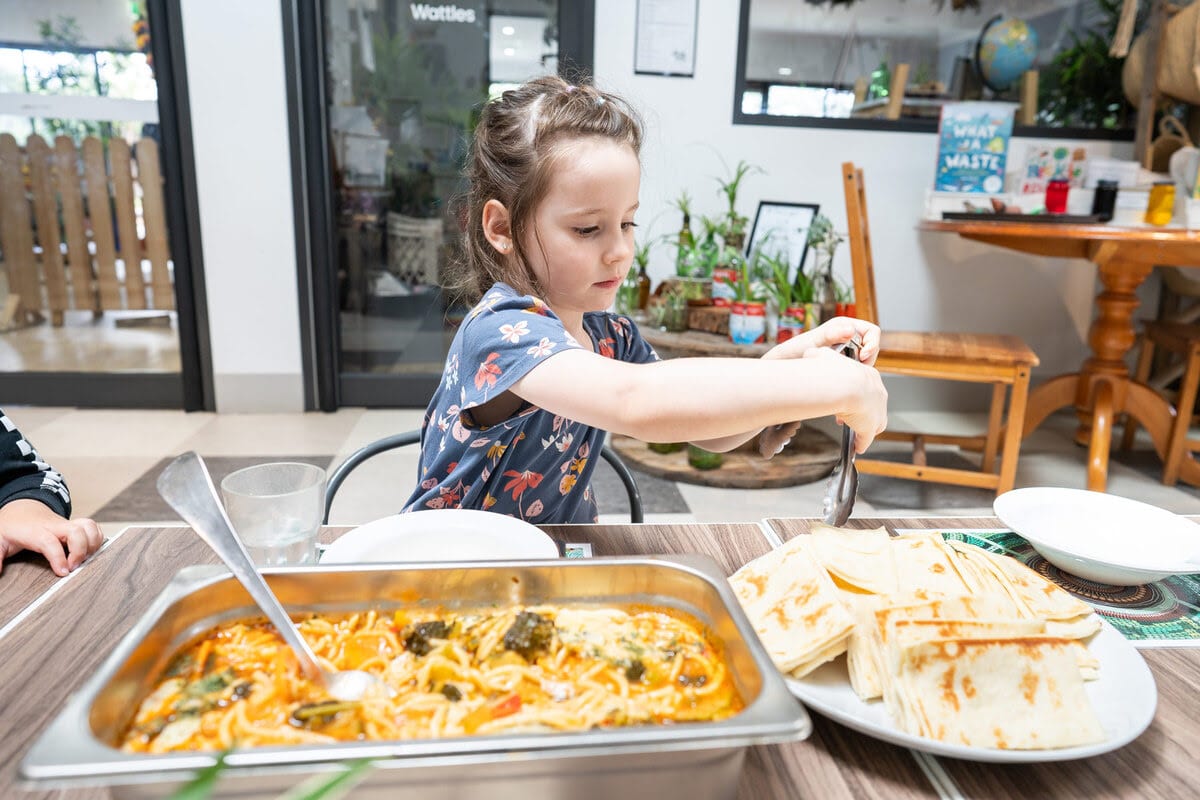
Fun Fact
Did you know that despite spaghetti and bolognese being a popular combination around the world, the traditional bolognese dish is served with tagliatelle, a flatter egg-based pasta similar to fettuccine?
Spaghetti’s integration into the dish can be traced back to American soldiers in World War II who, after tasting pasta in Bologna, incorporated it into their recipes upon returning home.
Furthermore, authentic bolognese always includes two types of meat: beef and pork. The earliest bolognese recipes describe a ragu served with pasta, highlighting the historical significance of this flavourful meat sauce.
Our beef and vegetable pasta is more than just a meal – it’s a celebration of flavours and culture. Perfect for family dinners or a cozy night in, this dish promises to satisfy both the young and the young-at-heart.
🍃 To tour one of our beautiful Centres, please click here. Otherwise, check out our website at Explorers Early Learning today!
Free Kinder and Kindergarten Funding: What’s the Difference?
What exactly is Free Kinder? And what’s Kindergarten funding? In this post, we spilt the difference between these often confused early childhood initiatives 👇
Early childhood education is the first step in ensuring academic (and lifelong) success for your child. Therefore, Kindergarten should be at the front of mind if your child is three or four-years-old.
However, there’s some confusion in Victoria around the different kinds of Government subsidised Kindergarten programs. Particularly, between ‘Free Kinder’ and ‘Kindergarten funding’.
Despite sounding similar, there’s a big difference between the two so to support families and clear up any misconceptions, we’ve outlined the differences between the often conflated Free Kinder and Kindergarten funding.
What is Kindergarten?
Kindergarten is the two years of early learning before your child begins primary school and is more commonly known as three and four-year-old Kindergarten.
Kindergarten programs are play-based and run by qualified Kindergarten teachers who hold a graduate diploma, bachelors degree, or masters degree. While these programs incorporate play-based learning, they emphasise essentials such as literacy, numeracy, social skills and emotional development.
In Victoria, these programs are guided by the Victorian Early Years Learning and Development Framework (VEYLF).
Kindergarten can be integrated into a long day care program at an early learning centre, or run as sessional programs at a church, community centre, or standalone Kindergarten service (this could include three-to-five hour blocks over a few days a week).
For a full breakdown of the difference between long day care and sessional Kindergarten, check out our blog post here.
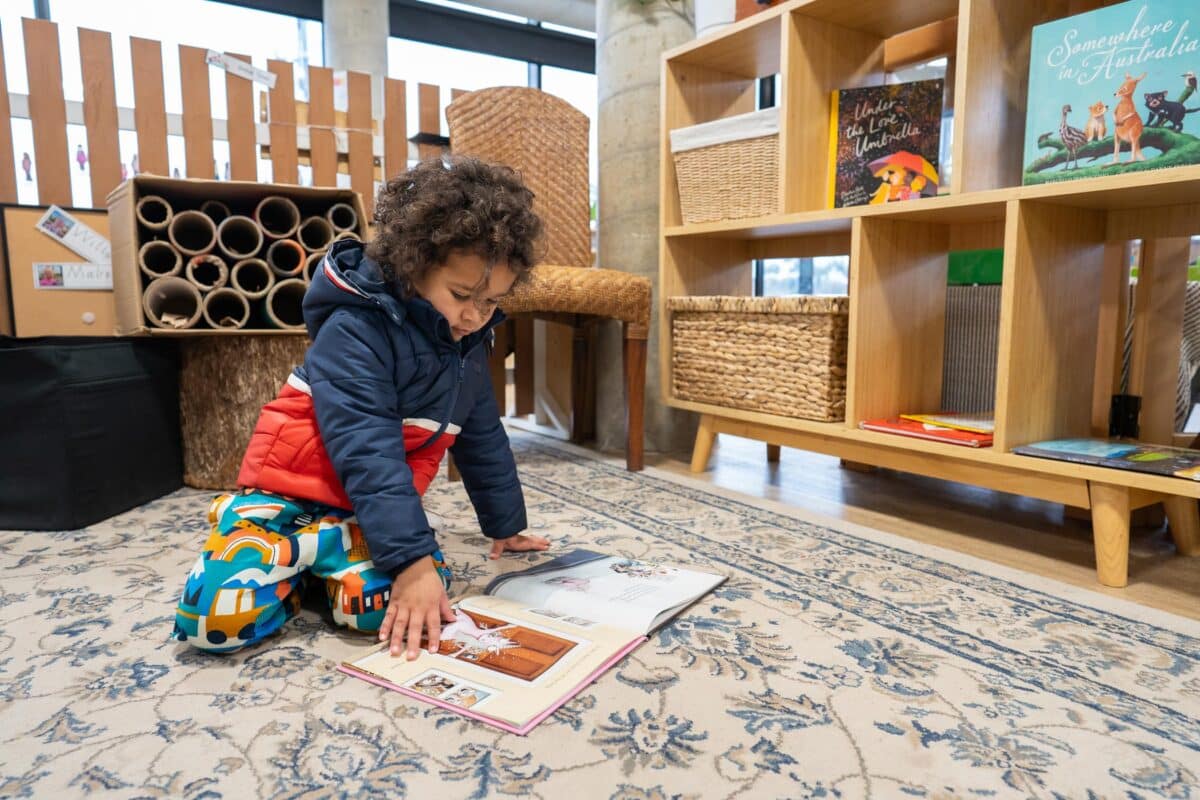
What is Kindergarten Funding?
Firstly, Kindergarten funding is not the same as Free Kinder. Rather, Kindergarten funding takes the form of subsidies provided directly from the Government to the childcare service you’ve nominated.
Therefore, when you enrol your child into Kindergarten, you are required to ‘claim funding’ with only one Kindergarten service. The Government will then allocate funds directly to that service.
These funds are used to directly benefit and enhance the service’s Kindergarten program. This can be done in several ways, such as:
- Employing staff members to directly deliver the funded Kindergarten program
- Kindergarten staff professional development
- Resources and equipment used for the funded Kindergarten program
- Excursions and incursions related to the funded Kindergarten program
- Extra support for educationally disadvantaged children
- Parental engagement
- Transition in and out of Kindergarten
- Specialist programs (e.g. music, science, languages)
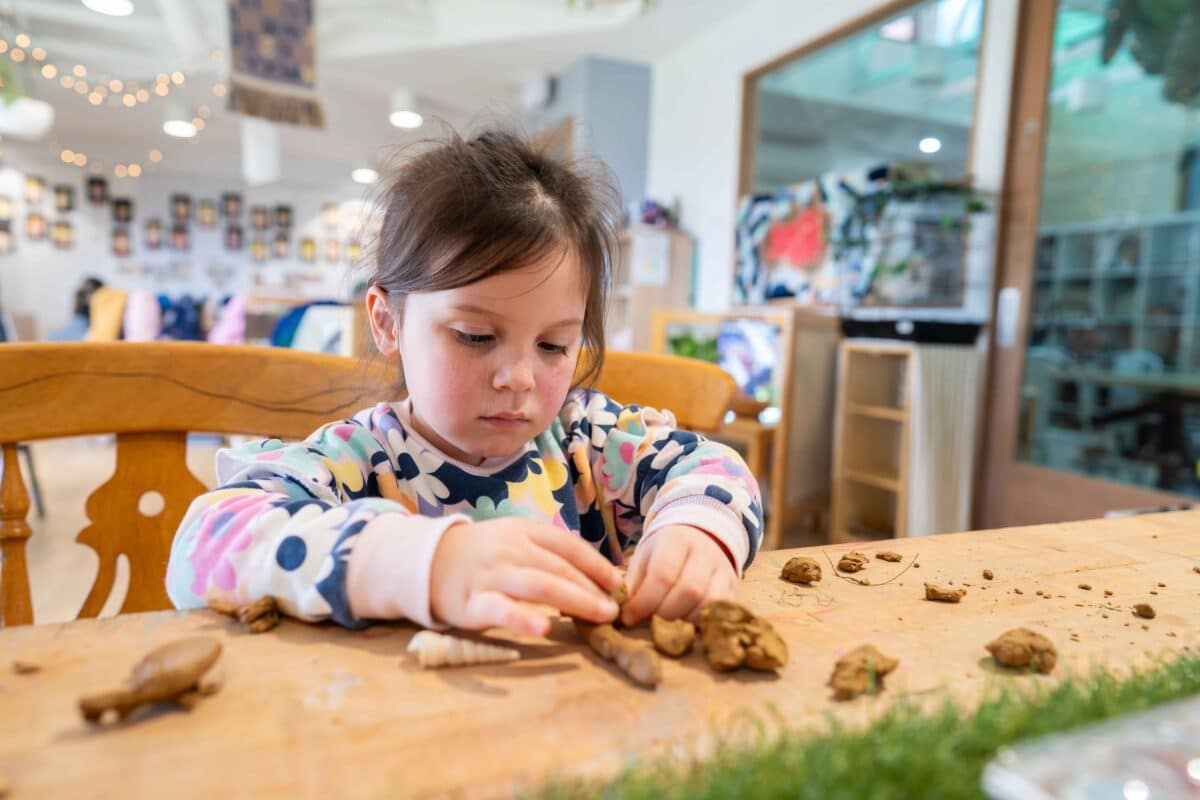
What is Free Kinder?
There’s a lot of confusion around what exactly is meant by ‘free’ Kinder.
In simple terms, ‘Free Kinder’ supports families to access a funded Kindergarten program by providing a discount of up to $2,500 per year to offset the out-of-pocket cost of your fees.
So, if your child attends less than $2,500 worth of Kindergarten in a calendar year, it is technically free Kindergarten.
Free Kinder at Explorers
If your child attends a long day care centre, such as Explorers, Kindergarten is integrated into the long day care program (if your child is three or four-years-old). You will receive the Free Kinder discount in the form of Free Kinder Credits.
These Credits act as a discount on your childcare fees, alongside any Child Care Subsidy (CCS) entitlements. Ultimately, this will reduce your out-of-pocket Kindergarten expenses.
As with all Free Kinder subsidies, Credits rely on the hours your child spends in the Kindergarten program.
In 2024, the State Government boosted the Kindergarten funding figures:
- Four-year-old Kindergarten children must be enrolled for at least two days per week and the funding covers 15 hours, totalling up to a maximum $2,050 for the year.
- Three-year-old Kindergarten children can access 7.5 hours (maximum $1,025) or 15 hours (maximum $2,050) depending on days of attendance and Kindergarten teacher placement.
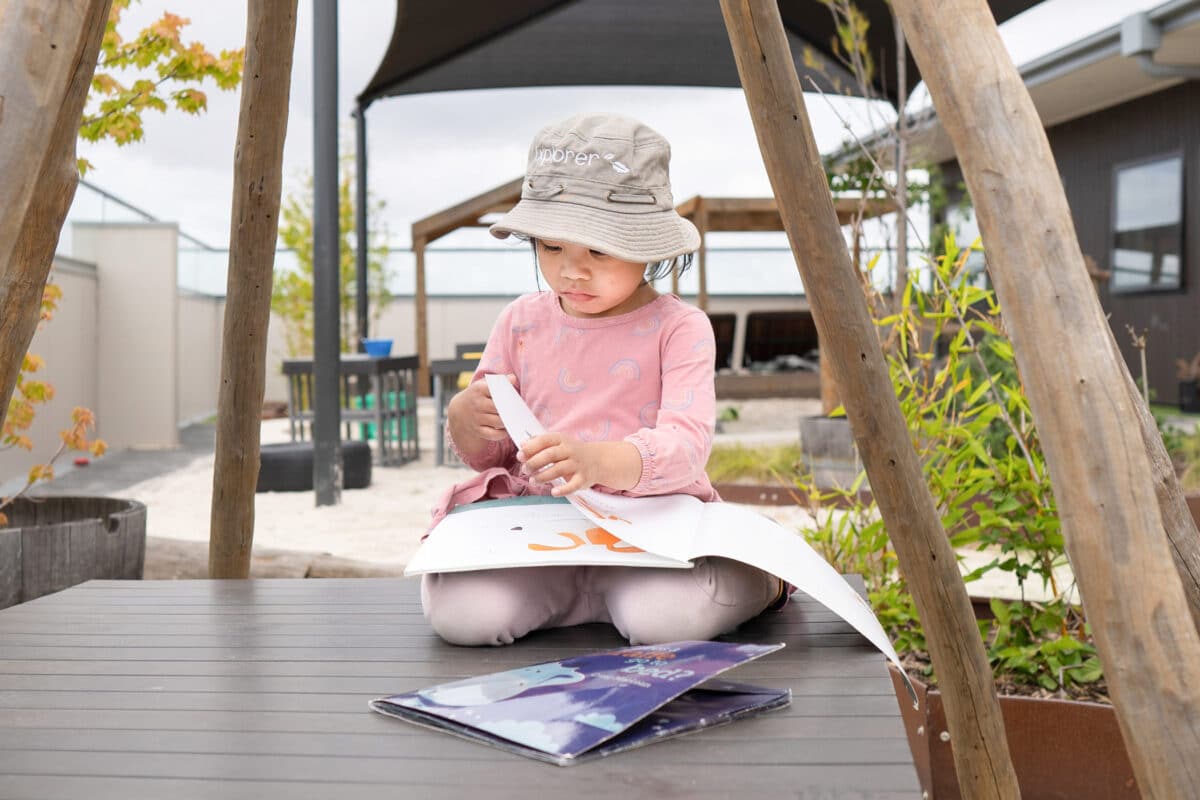
Free Kinder and Kindergarten funding are two incredible Government subsidised programs which are designed to enhance the quality and accessibility of Kindergarten. Over the next decade, the scale of Free Kinder and Kindergarten funding is planned to vastly expand.
By 2032, the State Government has proposed for regional areas to be better represented, accessibility for all families to be increased, and the hourly caps and Free Kinder discounts to be raised.
Furthermore, the Australian Government will be rolling out some major changes to the Child Care Subsidy (CCS) throughout 2025 and 2026, including the introduction of a new ‘3 Day Guarantee’ scheme.
Eager to know more about these CCS updates? Check out the our Explorers blog post here that breaks down everything you need to know.
🍃 To tour one of our beautiful Centres, please click here. Otherwise, check out our website to register your interest at Explorers Early Learning today!
25 STEAM-Themed World Space Week Books for Toddlers
Paper mâché planets and homemade star maps can only mean one thing – it’s Space Week! To celebrate this astronomical event, we’ve compiled our list of must-read STEAM books to get your toddler thinking big 🚀
World Space Week is the largest space event in the world with more than 11,221 events in 87 nations. Celebrated annually between October 4 – 10, Space Week is the perfect opportunity to ignite your child’s curiosity.
While experiments and trips to the museum are fun ways to get into the Space Week spirit, the first step is to get your toddler thinking big. And what better way than to dive into the wide world of books?
In this post, we’ve listed our top Space Week books which are fun and educational. Whether your child is a budding inventor or the next H.G. Wells, there’s something on this STEAM (science, technology, engineering, arts, maths) list for everyone!
Science
Children love science. From dazzling chemical reactions to mind-boggling facts about the Milky Way, it’s no wonder that children get lost for hours in these captivating reads. Additionally, a keen interest in science boosts children’s curiosity and imagination, so it’s always worth encouraging.
Whether it’s exploring the solar system, physics, or ecosystems, there’s so many science books to choose from:
- 8 Little Planets by Chris Ferrie, illustrated by Lizzy Doyle
- The Solar System: A Lift-the-Flap Book by Steven Wood
- Big Ideas for Little Environmentalists: Ecosystems with Rachel Carson by Maureen McQuerry, illustrated by Robin Rosenthal
- ABCs of Physics by Chris Ferrie
- Priddy Explorers: Space by Roger Priddy
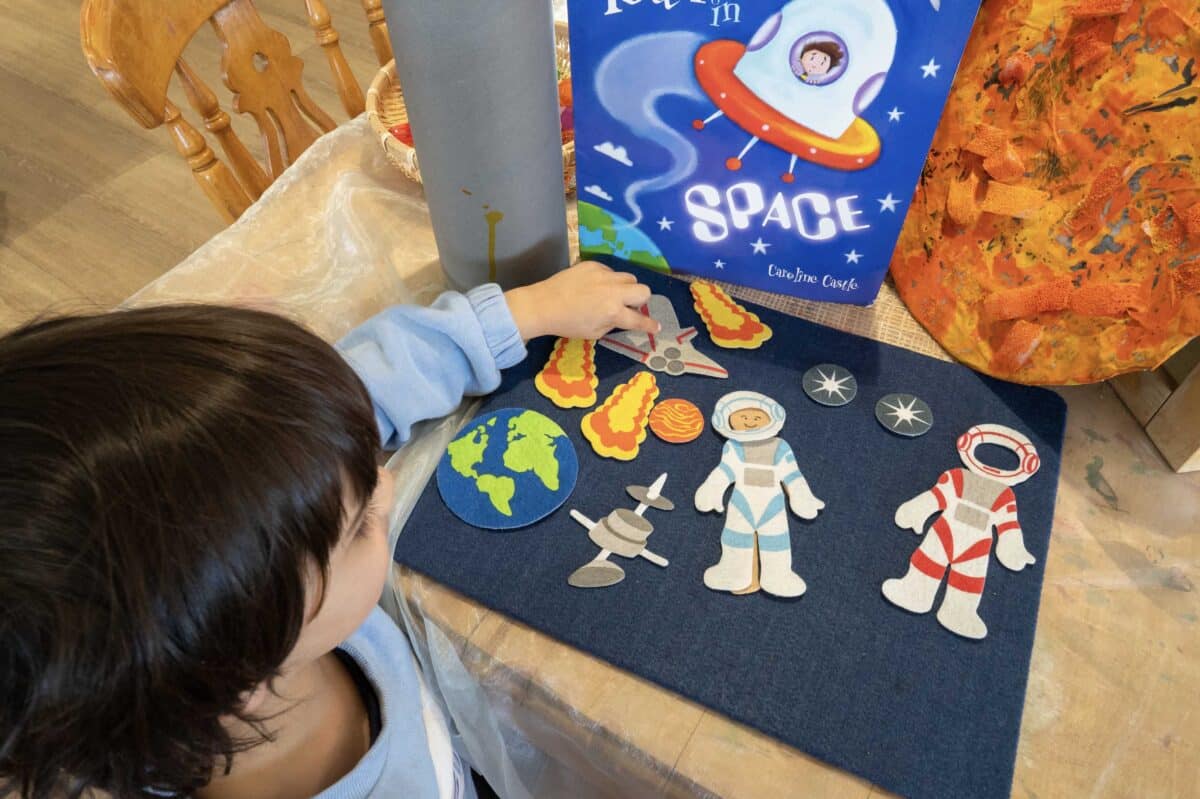
Technology
In today’s digital age, technology is everywhere. It shapes the way we live and interact with the world. Therefore, introducing your toddler to technology at an early age can set the foundation for success in school and the workplace.
From exploring the inner workings of robots to understanding coding; technology books open a world of possibilities for toddlers:
- Robots, Robots, Everywhere! by Sue Fliess and Bob Staake
- What Do Machines Do All Day? by Jo Nelson, illustrated by Aleksander Savic
- Peekaboo Car by Ingela P Arrhenius and Camilla Reid
- Help! My Robots are Lost in the City! by Webber Books
- Twinkle, Twinkle, Robot Beep by Jeffery Burton, illustrated by Zoe Waring
Engineering
Engineering is all about creativity and problem-solving. It’s the art of designing, building, and making things work. Therefore, introducing engineering concepts to toddlers fosters creativity, curiosity, and critical thinking skills.
Whether it’s building with blocks or learning about simple machines, engineering books spark ingenuity and inspires little builders and inventors:
- Baby Loves Structural Engineering! by Ruth Spiro, illustrated by Irene Chan
- Rocket Science for Babies by Chris Ferrie
- Things that Go by Becky Davies, illustrated by Mei Stoyva
- ABCs of Engineering by Chris Ferrie
- Baby Loves Coding! by Ruth Spiro
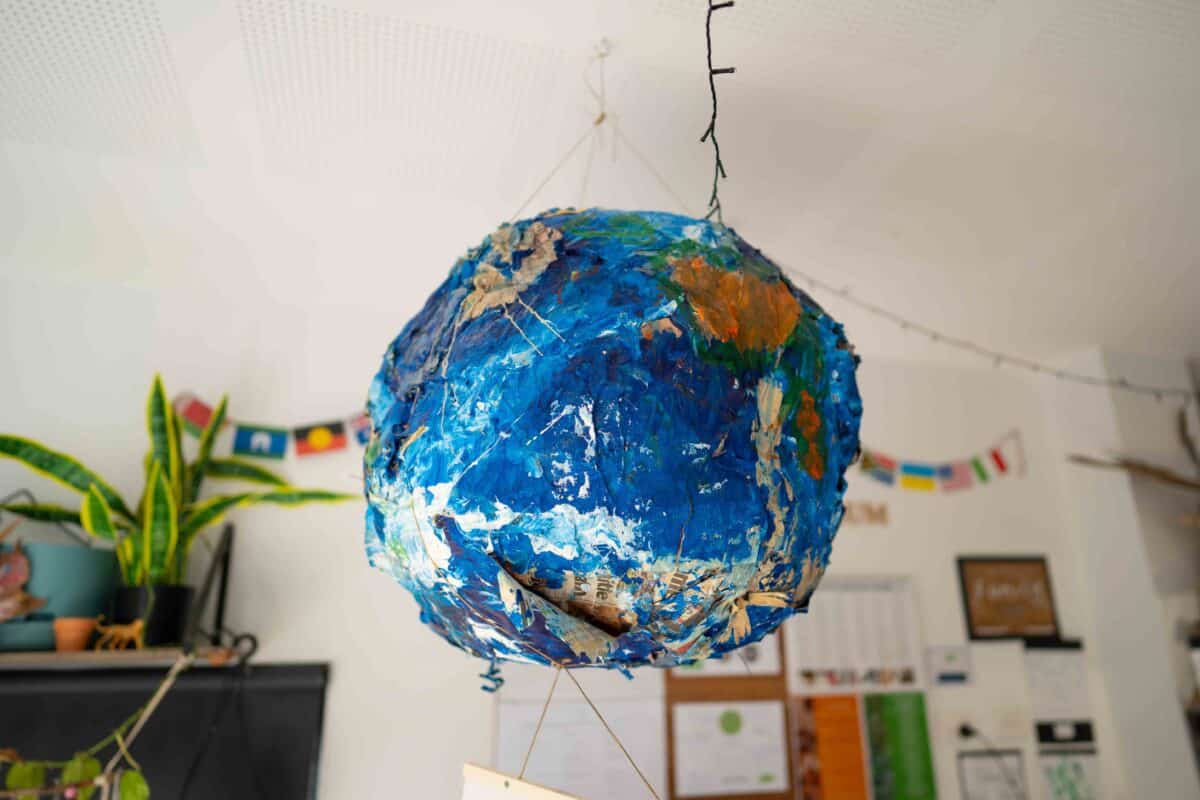
Arts
The world of arts is a boundless realm of imagination and self-expression. Encouraging your toddler to explore their artistic side is a journey of discovery. Additionally, arts encompass a wide range of activities from painting and drawing to music and dance.
These books explore space in their own unique ways with differing art styles, storytelling techniques, and points-of-view. Therefore, your child will gain a deeper appreciation for the beauty of artistic expression and how books – just one artform – can tell a deeper story:
- Life on Mars by Jon Agee
- Curious George and the Rocket by Margret Rey, illustrated by H. A. Rey
- Meanwhile Back on Earth by Oliver Jeffers
- Pop-up Peekaboo! Space by DK
- Bizzy Bear: Space Rocket by Benji Davies
Maths
Maths is the language of the universe, and it’s never too early to introduce your toddler to its wonders. Likewise, maths isn’t just about numbers. It’s about patterns, shapes, and problem-solving.
Importantly, these maths books make understanding the foundations of academic success fun! Before long, you might even find your child looking forward to solving equations and counting all on their own:
- Peck Peck Peck by Lucy Cousins
- ABCs of Mathematics by Chris Ferrie
- How Many Legs? by Kes Grey, illustrated by Jim Field
- Space Baby: Blast Off! by Pat-a-Cake, illustrated by Kat Uno
- One is a Snail, Ten is a Crab by April Pulley Sayre and Randy Cecil
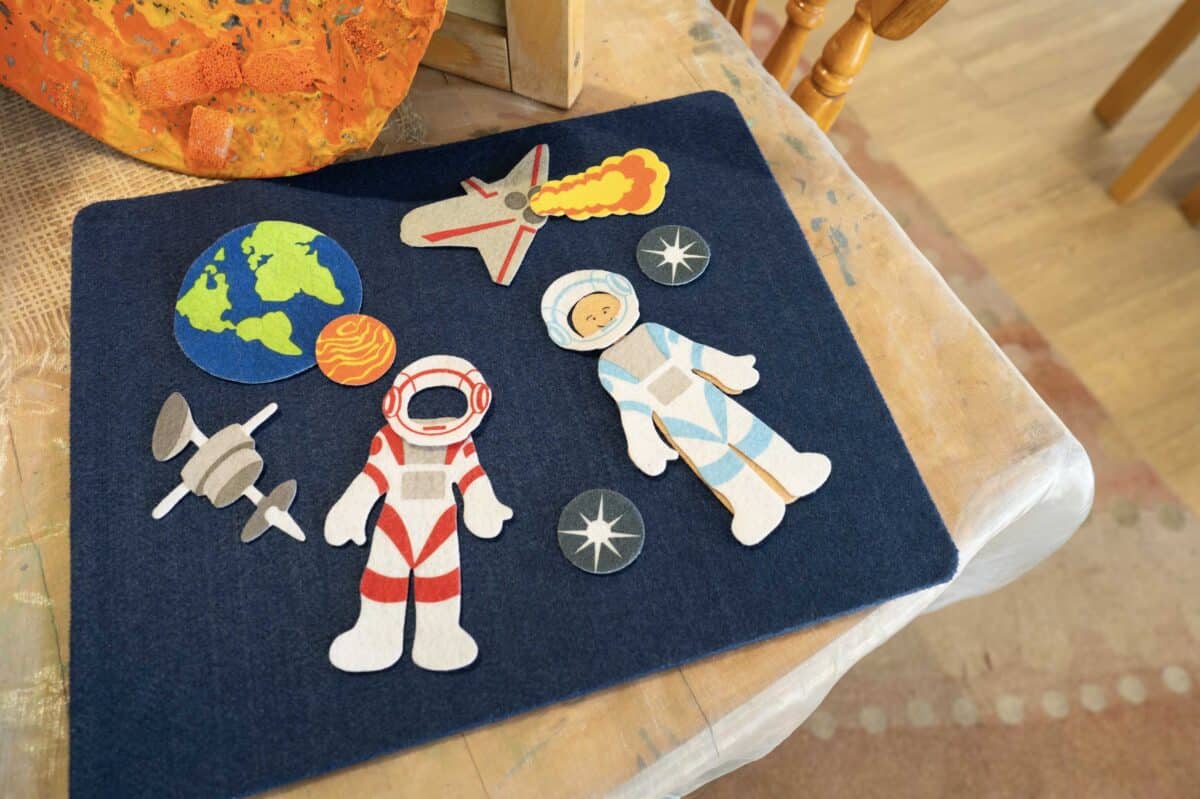
Overall, exploring these spacey, STEAM-themed books is a fantastic way to nurture your toddler’s curiosity and a life-long love for learning. Science, technology, engineering, arts, and maths are all integral parts of the rich tapestry of knowledge which shape your child’s understanding of the world. As you embark on this literary adventure, remember to encourage questions and engage in discussion with your child.
So why not dive into these captivating books together and watch your child’s imagination light the darkest corners of the great unknown?
🍃 To tour one of our beautiful Centres, please click here. Otherwise, check out our website to register your interest at Explorers Early Learning today!
Returning to Work After Parental Leave: What to Expect
Are you dreading that first day back in the office? If so, read on for our full breakdown of how different kinds of leave, medical resources, and simple tips can help you navigate your return to work!
When you’re cosied up on the couch with your new bundle of joy, returning to work is probably the last thing on your mind. Likewise, the period following childbirth or adoption is a mix of emotions, milestones, and precious memories you’ll carry for life.
However, if you’ve made the decision to return to work, the first day will come around before you know it! While you might think you’ll settle back into the rhythm right away, parents often struggle to ease back into the work-life balance.
To make sure you’re ready for that first day back on the job, we’ve broken down parental leave, your entitlements, and some handy tips to keep in mind!
What is Parental Leave?
Unpaid Parental Leave
In Australia, all employees are eligible for unpaid parental leave if they have completed at least 12 months of continuous service with their employer.
This entitlement applies to an employee that gives birth, an employee whose de-facto partner gives birth, or an employee who adopts a child aged under 16.
Eligible employees are entitled to 12 months of unpaid parental leave, with the option to request an extension for a further 12 months.
For information on other types of leave (such as pre-adoption leave), click here.
Australian Government Paid Parental Leave
As of July 1 2023, the Australian Government Paid Parental Leave scheme provides the following additional support to eligible employees:
- A combined 20 weeks government-funded paid leave that is paid at the national minimum wage and shared between you and your de-facto partner. In summary, government funded paid parental leave:
i) can only be claimed at a workplace where you or your partner have worked for at least 12 months.
ii) must be shared, i.e., one partner can’t use more than 90% (18) of the 20 weeks (unless a single parent).
iii) must be used within 12 months of birth by the primary caregiver, while the secondary caregiver can use the leave within 24 months.
iv) doesn’t have to be taken all at once. For example, you could take one day off a week over several months.
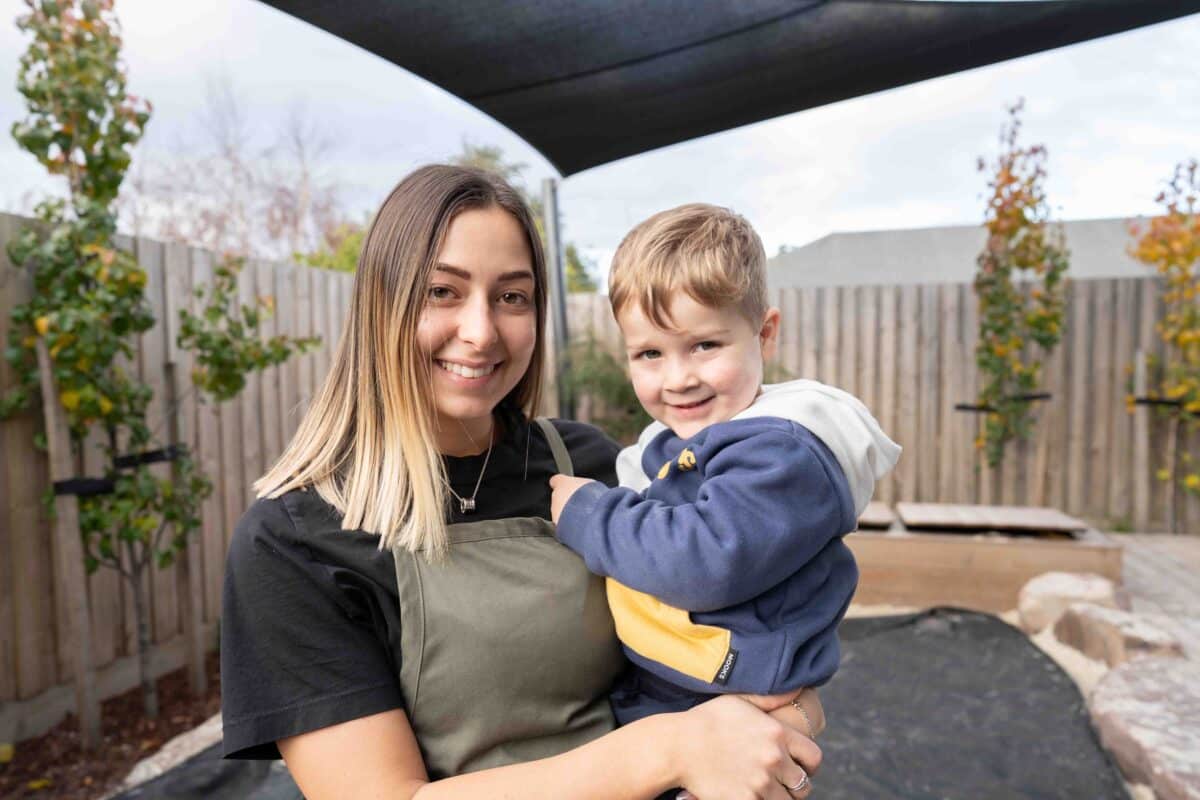
Employer Funded Paid Parental Leave
Some employers offer additional paid parental leave to new parents. The amount of leave and pay entitlements are at the discretion of each employer and will be detailed in enterprise agreements or contracts of employment.
Moreover, employer funded parental leave doesn’t affect an employer’s eligibility for the government funded paid parental leave scheme.
Your Rights When Returning to Work
An employee returning from unpaid parental leave is entitled to:
- Return to their old role or one of equal pay and responsibilities upon their return.
- Request flexible working arrangements such as working reduced hours or adjusting start and finish times.
- Support if they’re breastfeeding. For example, your workplace must make reasonable efforts for those expressing breastmilk at work. These include providing a clean and private area (not a toilet), access to a fridge to store the milk, an area to store your manual or electric pump (if you use one), a hand washing station, and regular breaks.
For more information, click here.
Return to Work Tips
To help you mentally prepare for the coming transition, we’ve listed some everyday steps you can take to reduce the dread of that fast-approaching first day back!
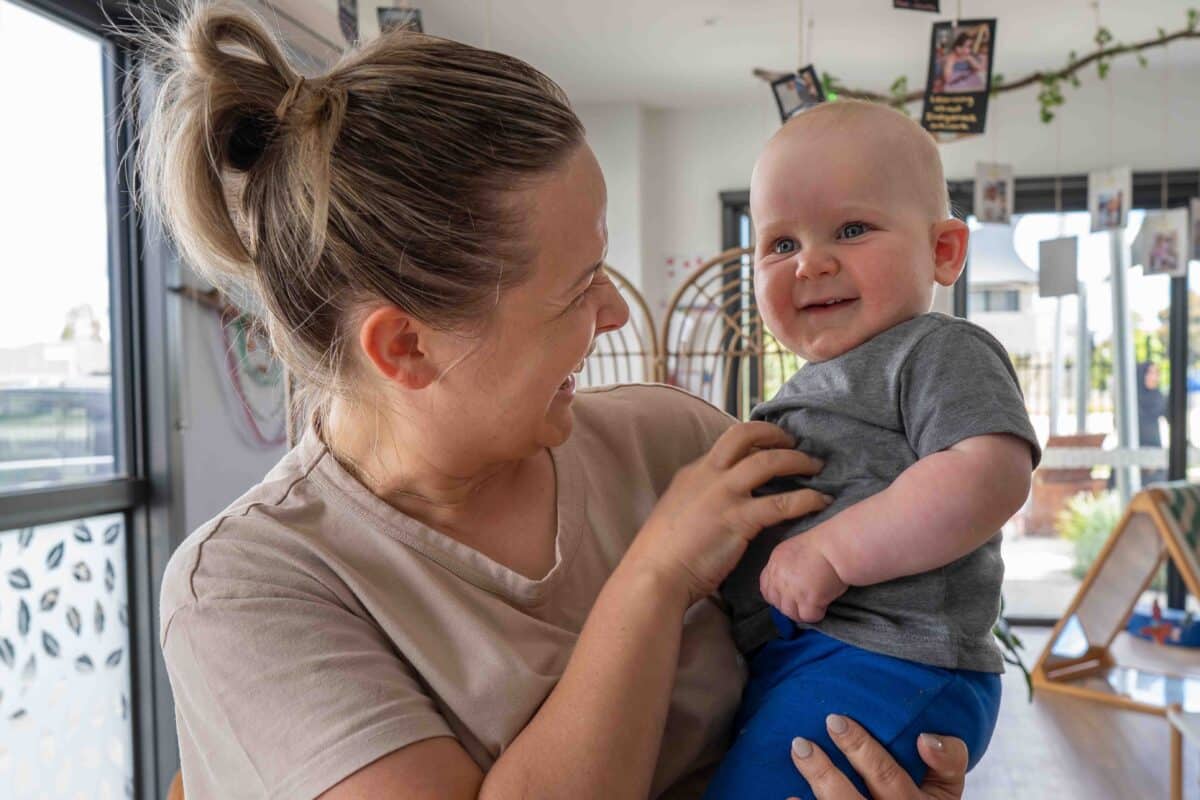
1. Keep an Open Mind
If you were working full-time before going on parental leave, don’t assume you’ll slide right back into your old routine like nothing happened. If you feel you need an extra year to care for your child, you can request this with your employer. Likewise, if you have family support or childcare organised and you want to jump back into your career earlier, that’s also okay!
Every child is unique, and their development and dependency differ greatly. Be sure to discuss any questions or concerns with a healthcare professional, and work with them to develop your return-to-work pathway. This may involve returning on a part-time or casual basis or taking on less responsibilities.
2. Organise Childcare in Advance
If you’re enrolling your child into childcare, don’t leave it until the last minute. Most early learning providers have waitlists, as well as orientation and induction processes. Also, you’ll want to give yourself as much time as possible to acclimatise your child into care and find the best fit.
If you’re looking for Reggio Emilia inspired early childhood education to give your child the best start, why not take a tour of one of our Explorers Centres? Explorers offers premium quality early childhood education and care from six weeks to school age!
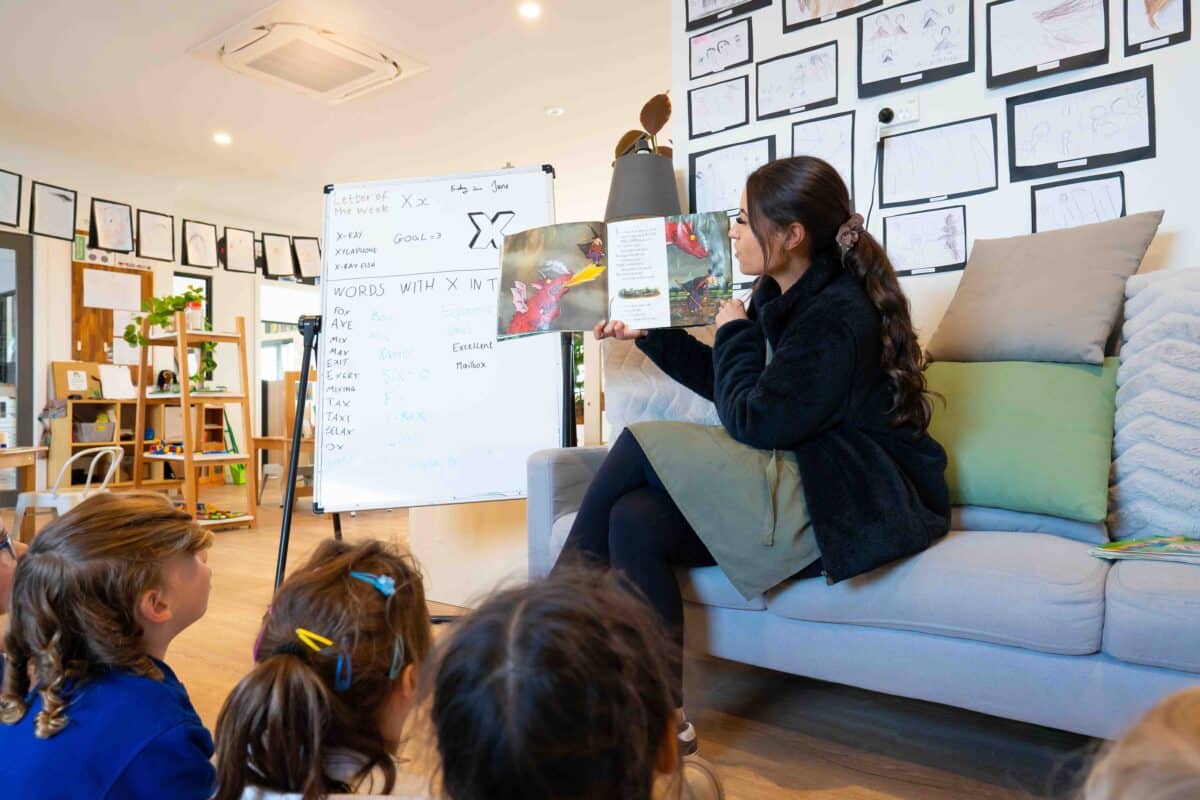
3. Stay in the Loop!
It’s tempting to shelve any thought of work during parental leave. After all, it’s time off right? However, it’s important to keep tabs on your workplace and stay in touch with colleagues and old work friends, particularly as you near your return date. This doesn’t have to be formal – something as simple as a catchup over coffee goes a long way!
This will help you avoid the culture shock of returning to work and seeing all the new faces or a new direction of the business. Moreover, it will give you valuable information and insights to inform your decision of when, and in what capacity, you’ll return to work.
Additionally, you can request to work up to 10 days while on parental leave through keeping in touch days. These could be for a conference, training days, or just to keep involved in the business. They don’t have to be taken all at once and can be for part of a day. The payment for these days is your normal wage and you accumulate your usual leave entitlements too!
4. Consider Working from Home
A common contributor to the returning to work nerves are feelings of guilt and anxiety when leaving your child on their own for the first time.
While this is a completely normal and natural reaction, it can be eased by working from home if this an option with your employer. Flexible work arrangements remove commute time, allow you to tend to appointments and checkups, so long as you have in-home care of a family support network.
5. Don’t Be Too Hard on Yourself
Don’t forget to prioritise self-care during the transition back to work. The demands of parenthood and work can be overwhelming, so it’s essential to carve out time for yourself.
Whether it’s taking short breaks, practicing mindfulness, leaning on family and friends, or engaging in physical activities, self-care will help you maintain your well-being and perform better both at home and in the workplace.
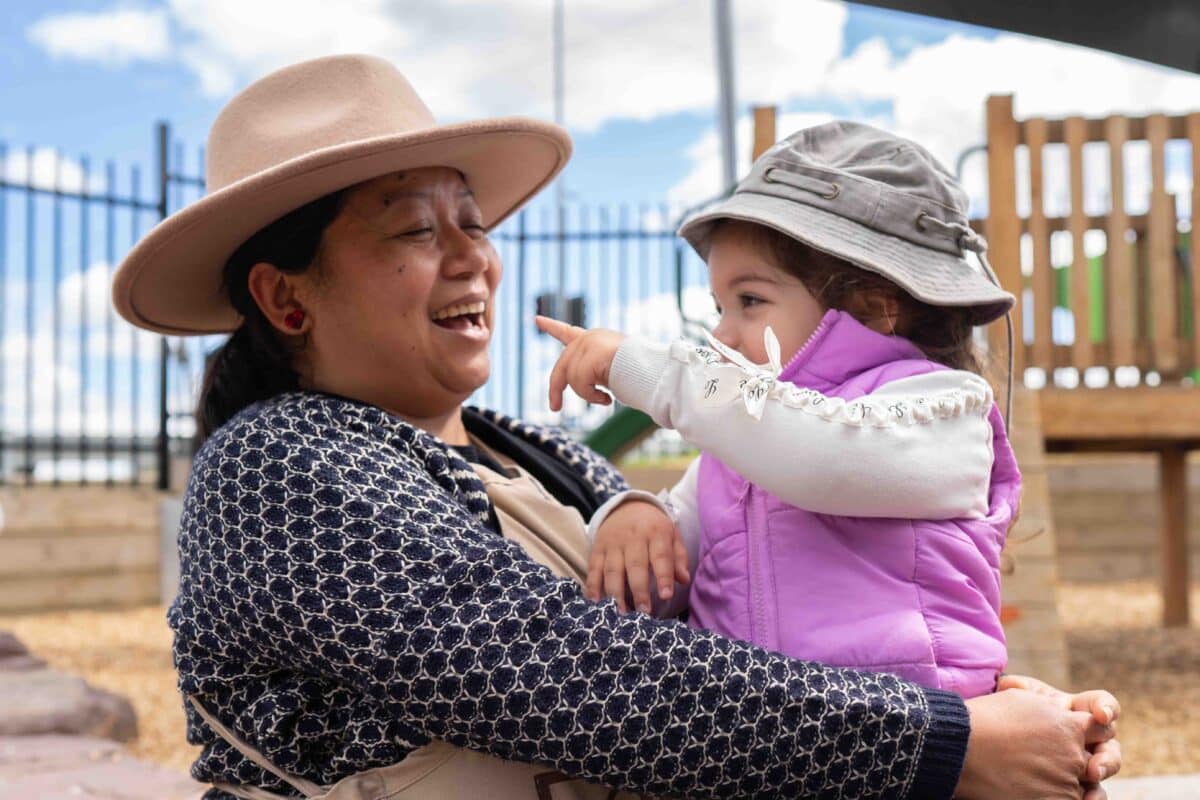
6. Sit Down with Your Boss
Open and honest communication with your employer is vital before, during, and after parental leave. Discuss your expectations, responsibilities, and any potential adjustments to your workload.
Many employers are willing to accommodate new parents, offering flexible hours or remote work options. Importantly, it’s a chance to be express any points of worry or anxiety so they can be ironed out before your return to work. If you don’t feel comfortable speaking with your boss, try your human resources department or union representative.
Be sure to understand your rights and entitlements under the Paid Parental Leave Act (2010) or any other applicable laws.
7. Reach Out if You’re Struggling
Building a strong support network is essential for working parents. Reach out to family, friends, colleagues, medical professionals, and other parents who can offer advice, assistance, or simply a listening ear when you need it. Consider joining local parenting groups or online communities to connect with others facing similar challenges.
Returning to work after parental leave is a significant life transition, and it’s entirely natural to feel a mixture of excitement and worry. By following these tips, you can ease the process, maintain your well-being, and ensure a smooth transition both at home and in the workplace.
Just remember that you’re not alone. With the right support and mindset, you can focus on what matters most – building memories with your newest addition to the family!
🍃 To tour one of our beautiful Centres, please click here. Otherwise, check out our website to register your interest at Explorers Early Learning today!
The First 1000 Days of Life: Why They’re So Important
What are the first 1000 days of human life? And how can you best prepare your child through those exciting early years? Read on for our full breakdown of this precious early childhood journey 👇
The first 1000 days of life, from conception until their second birthday, sets the foundation for your child’s emotional, physical, and academic development. As you can imagine, getting them right is essential. It’s a time full of developmental milestones, precious memories and yes – lots of nappy changes.
In this article, we outline what to expect during your child’s first 1000 days to help you prepare for this incredible early childhood journey.
Prenatal Care and Development
Prenatal care is everything, and we’re lucky in Australia to have free public healthcare and a range of comprehensive private health insurance options. It goes without saying that it’s vital to receive regular medical check-ups, eat a balanced diet, take prenatal vitamins (particularly calcium, vitamin D and folic acid), and check a list of DO’s and DON’Ts to best support your baby’s growth.
In the first months after conception, your baby’s organs develop rapidly and you’ll feel their first flutters of movement sometime between week 16 and 24!
Additionally, studies have suggested that playing soothing music may aid in cognitive development even in the womb. Just make sure the volume is below 50 decibels, which his roughly the same volume as a washing machine.
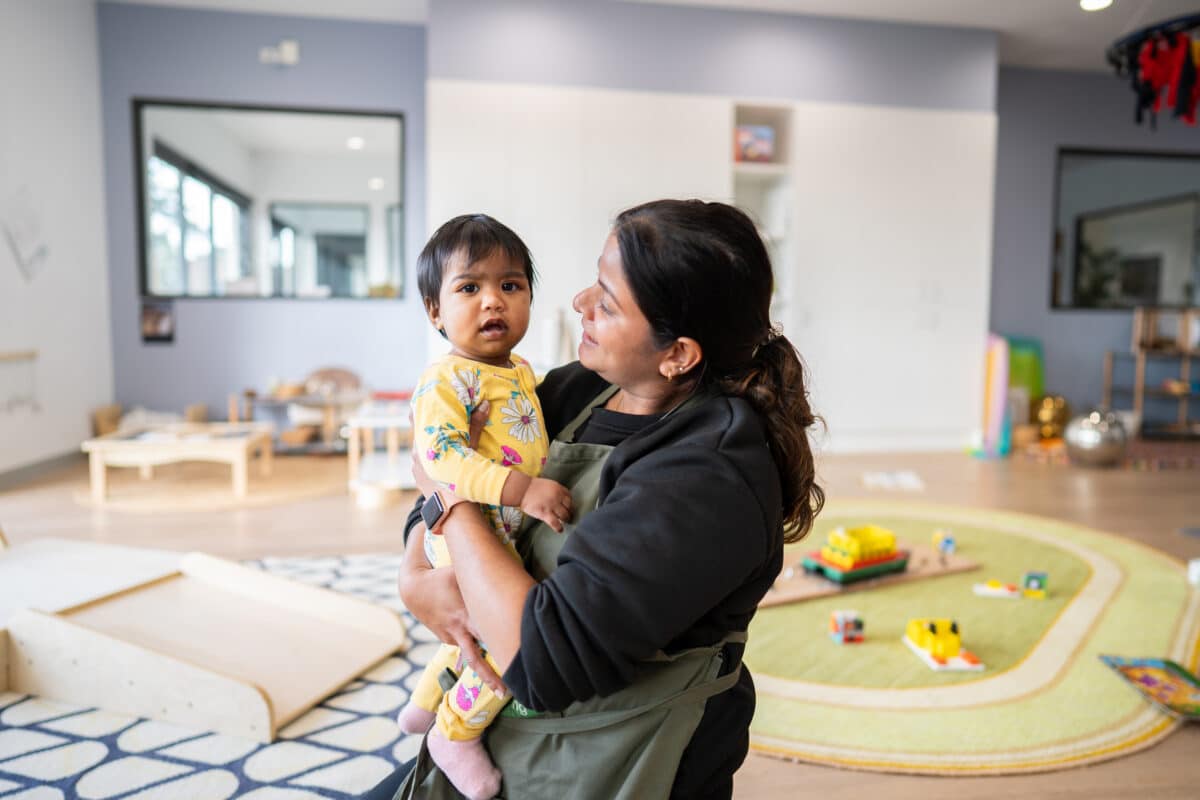
Birth and the Newborn Phase
The moment your baby arrives is a rush of emotion and relief. In the early days, you and your baby will mostly be getting to know each other. Expect round-the-clock feeding, checking, nappy changes, and lots of cuddles!
Moreover, regular postnatal checks with your GP are a must. Better Health Victoria recommends a check-up at around the six to eight week mark. This is also a great time to raise any questions or concerns.
Additionally, the Victorian Maternal and Child Health (MCH) Service is a free universal primary health service for all Victorian families with children that offers regular check-ups from birth all the way up to school age. This includes:
- Maternal and child health service resources
- Advice for sleep and settling
- Early Parenting Centres
- Aboriginal Maternal and Child Health Aboriginal-led MCH services
- Baby Bundle
While it can be easy to be overwhelmed at this early stage of development, try and enjoy these precious moments of bonding. Importantly, remember to reach out for support and guidance from loved ones or healthcare professionals if needed.
Infant Milestones
As your child passes through the first 1000 days, it’ll feel like they surpass milestones every other week. From their first smile to rolling over, sitting up, and eventually crawling, each accomplishment marks their progression physically and psychologically.
Some milestones to anticipate include:
- Birth to 3 months – lifting their head when lying on your stomach
- 4 to 6 months – rolling over, clapping, babbling
- 7 to 9 months – sitting without support
- 10 to 18 months – taking their first steps
- 13 to 18 months – engaging in pretend play, first words
- 19 to 24 months – sorting shapes and colours, identifying objects, passing things
Keep in mind that these aren’t strict timeframes. Each child develops at their own pace and may surpass these milestones well before or after these windows. During this time, you can encourage their development through tummy time, talking to them, and introducing age-appropriate toys and activities.
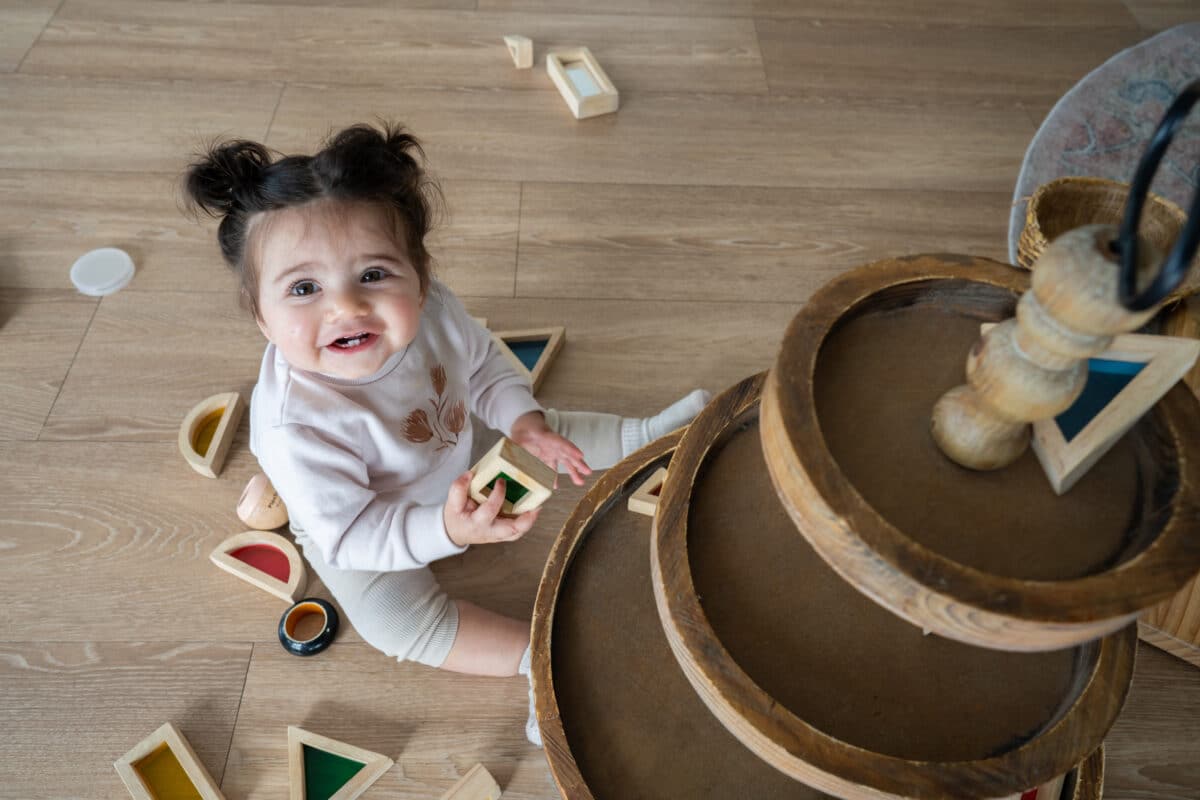
Nutrition and Weaning
Nutrition plays a vital role in your child’s growth and development during the first 1000 days. Breast milk, or an appropriate infant formula, is essential for the first six months. Thereafter, you can gradually transition to age-appropriate foods while continuing to breastfeed or offer formula for 2 years or beyond.
Solid foods can be introduced from around six months, which opens a whole new world of tastes, textures, and smells.
Just remember to be patient as your baby explores different foods and adapts to a varied diet. If you have any concerns, be sure to consult your GP or paediatrician regarding specific dietary needs, allergens, or intolerances.
Language and Cognitive Development
During the first 1000 days, your baby’s brain is rapidly developing, laying the foundation for future learning and communication. Some activities to help your child from around the one year mark include:
- Lots of talking and singing
- Reading books together
- Messy play
- Puzzles
- Art
And it doesn’t always have to be so structured. Something as simple as responding to your child’s babbles and engaging verbally promotes their understanding of the world around them (and makes for a great time!). Try to enjoy these moments of discovery together.
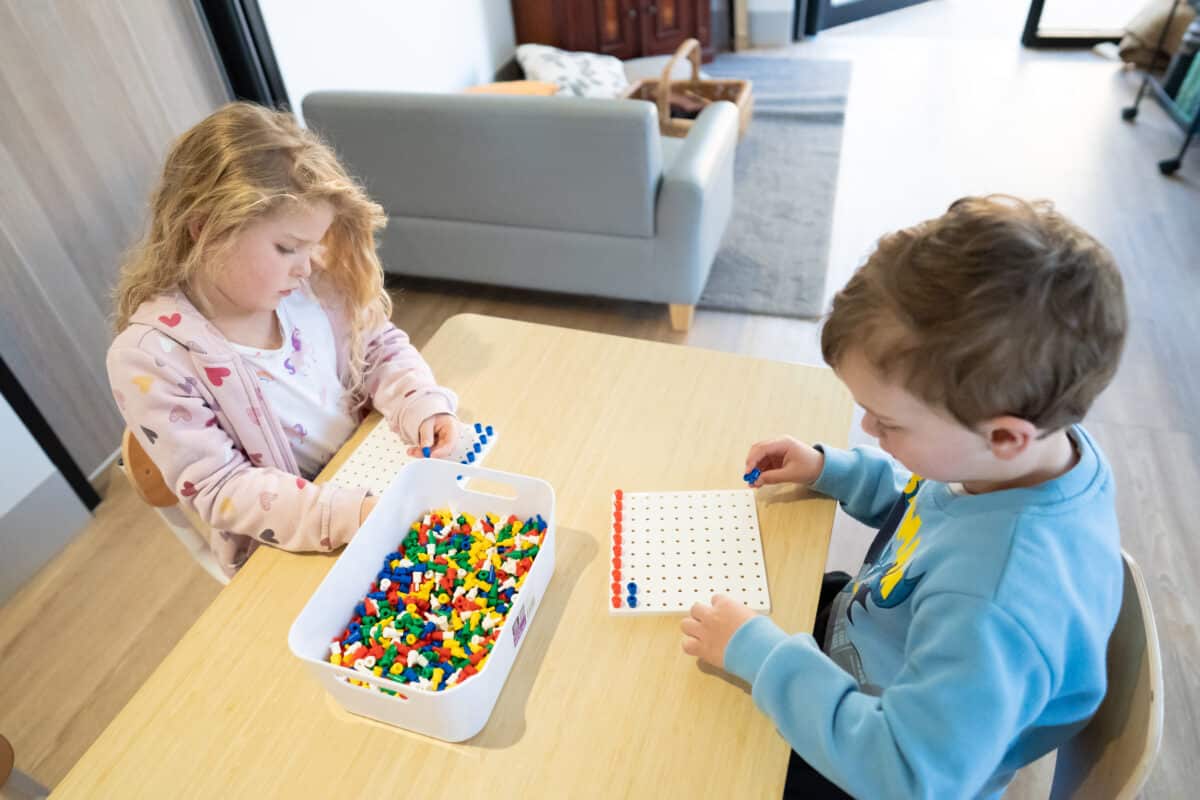
Social and Emotional Development
As your baby grows physically between the one and two year mark, so do their social and emotional skills. Responding to their cues, providing a secure and loving environment, and fostering social interactions with other children nurtures their emotional well-being.
Likewise, be sure to celebrate their achievements verbally and enthusiastically. This not only provides comfort during times of frustration or distress, but rewards children’s curiosity and insatiable hunger to discover and explore.
For parents that are returning to work during the first 1000 days, be assured that Explorers Early Learning offers opportunities for further social and cognitive development.
Overall, the first 1000 days of a child’s life is a time of immense growth and development. From prenatal care to their second birthday, this period shapes their future health, well-being, and development from the cot all the way to adulthood.
Embrace each milestone, enjoy the precious moments, and seek support when needed. Remember, every child is unique, so follow your instincts and trust your best judgement – no one knows your child better than you!
🍃 To tour one of our beautiful Centres, please click here. Otherwise, check out our website to register your interest at Explorers Early Learning today!
Long Day Care and Sessional Kindergarten: What’s the Difference?
Are you tossing up between long day care and sessional Kindergarten? What if we told you that you can get the best of both worlds through integrated Kindergarten? Read on for our breakdown of these two early learning journeys 👇
The Victorian Government’s Best Start, Best Life program, which has pledged billions into the early learning sector, is generating plenty of buzz around long day care (LDC) centres and sessional Kindergartens.
The choice between LDC and sessional Kindergarten is ultimately up to you. While some prefer the traditional style of sessional Kindergarten, more and more families are taking advantage of LDC with integrated Kindergarten Programs.
With extended operating hours and holistic learning opportunities for children, LDC is a reliable choice that combines care and education, while also accommodating families with even the busiest of schedules!
But what exactly is the difference between these two forms of early education, and how do they impact your child’s transition into primary school?
In this post, we break down the key differences between sessional Kindergarten and long day care,
Long Day Care (LDC)
LDC, often called ‘childcare’ or ‘day care’, are centre-based early learning services provided by childcare professionals (educators) for children as young as six weeks old to school age (six years old in Victoria).
These centres develop their own curriculums guided by the Early Years Leaning Framework (EYLF). Additionally, LDC services provide meals and offer a range of extracurricular activities such as languages, sports, gardening, and multi-sensory workshops.
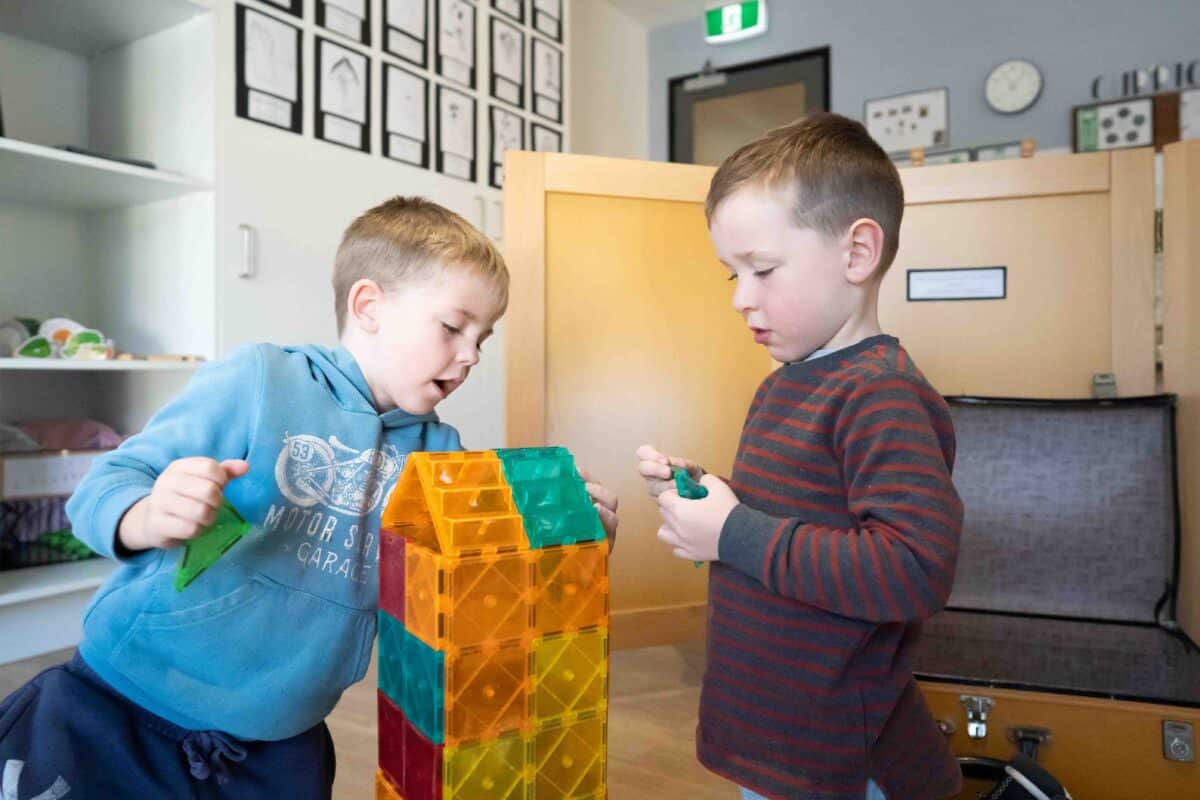
LDC centres can be privately or government owned, family-run, or operated by local community groups. However, all must meet the National Quality Standard (NQS) and are assessed and rated accordingly.
Importantly, all LDC educators are required by the Department of Education to have completed, or be actively working towards, a recognised ACECQA (Australian’s Children Education and Care Quality Authority) qualification:
- Certificate III in Early Childhood Education
- Diploma of Early Childhood Education
- Bachelor of Education (Early Childhood) or equivalent
Educators are also required to have:
- A Valid Working with Children Check
- First Aid Training
- CPR Training
- Asthma and Anaphylaxis Training
- Child Protection Training
Additionally, LDC centres operate longer hours than sessional Kindergartens, opening as early as 6am and closing as late as 7pm. Ultimately, this accommodates working and/or studying parents and guardians.
In short, the flexibility of LDC allows parents to enrol their child into care depending on their specific needs, rather than their provider’s schedule.
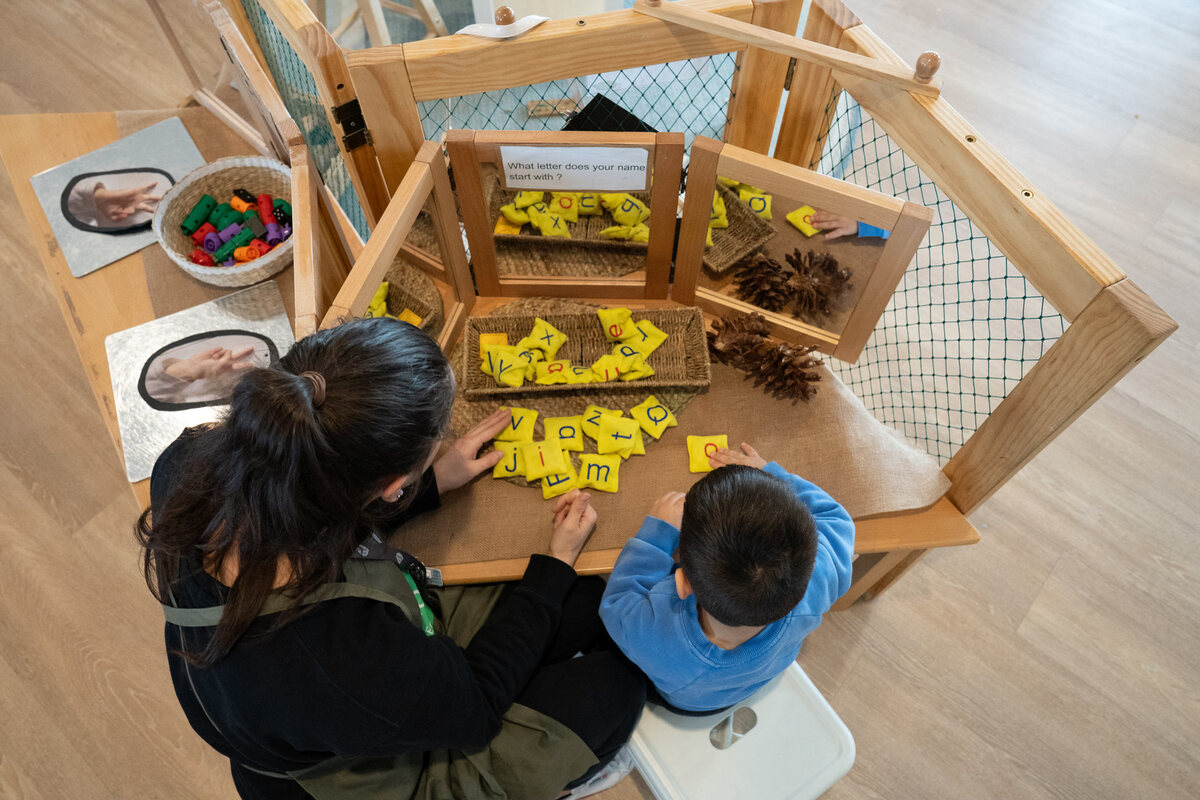
Sessional Kindergarten
Sessional Kindergarten, or ‘preschool’, is a one-to-two-year program for three and four-year old children. Notably, sessional Kindergarten differs from LDC as they operate on specified session times. Often, these are in three to five-hour blocks over two-to-three days per week.
Moreover, sessional Kindergarten can be run by local governments, churches, private companies, or independent schools and vary in fees and funding. They’re typically more formal than LDC as children often have to bring their own food, learning materials, and even wear uniforms in some services.
Kindergarten Teachers at sessional Kindergarten must hold a tertiary qualification:
- Graduate Diploma of Early Childhood Education
- Bachelor of Education (Early Childhood)
- Master of Teaching (Early Childhood)
In Victoria, Kindergarten for three and four year old children is not compulsory. Nevertheless, many parents enrol their child into sessional Kindergarten or LDC with integrated Kindergarten programs before beginning primary school.
Integrated Kindergarten at Explorers
At Explorers, we offer an integrated Kindergarten Program within our long daycare Centres which is guided by Bachelor qualified teachers across the week for our three and four-year-old children. This program gives children first-hand knowledge and confidence to begin their school journey.
Our Reggio Emilia-inspired program is carefully designed to ease children into the rhythm of primary school, rather than forcing them into a strict routine that can be overwhelming and even traumatic for some children.
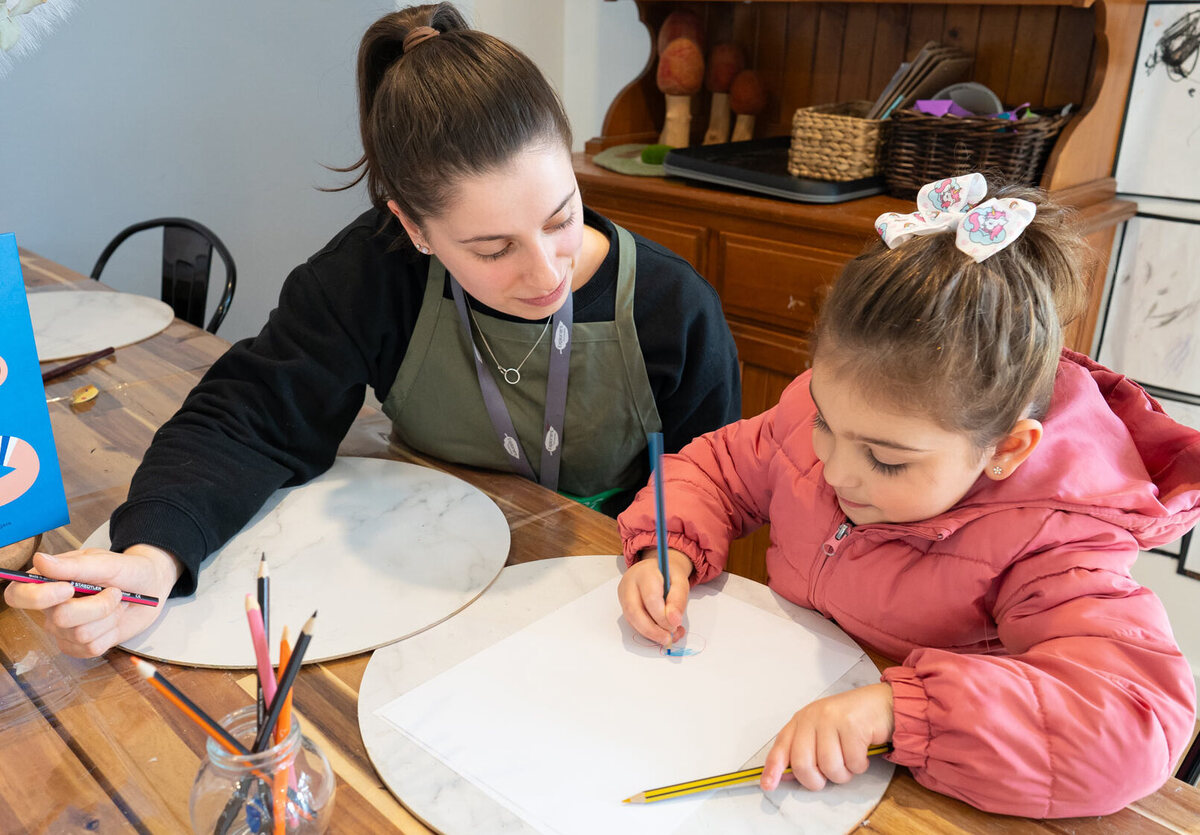
We focus on key areas of your child’s development to best prepare them for their transition to primary school:
- Wellbeing
- Self Regulation
- Cognitive Skills
- Communication
- Positive Attitudes towards Learning
- Respect for Diversity
- Autonomy
Overall, integrated Kindergarten gives you the best of both worlds. Children receive Kindergarten quality education and parents benefit from the flexibility of LDC. Learn more about Explorers Kindergarten Program.
🍃 To tour one of our beautiful Centres, please click here. Otherwise, check out our website to register your interest at Explorers Early Learning today!
Children and the Dinosaur Phase: The Benefits of Fascination
What is it with children and dinosaurs? No matter the generation, there’s no escaping the dinosaur phase! But have you ever wondered what’s behind it? It may be more important for early childhood development than you think 🦖
Is your child watching The Land Before Time on repeat? If so, they’re probably in the famous ‘dinosaur phase’ – a time when children become obsessed with all things prehistoric.
The dinosaur phase usually begins around age two or three and can last well into primary school. While it might seem like a passing fad that’ll make for some great additions to the photo album, it may also contribute to your child’s creativity and cognitive development.
In this article, we explore all the benefits of the dinosaur phase, even if your living room does become a temporary velociraptor enclosure.
Promotes Curiosity and Exploration
Children in the dinosaur phase are naturally curious about the world around them. They ask the big questions, seek answers, and investigate new ideas. Naturally, this leads to stimulating learning experiences as they read and discover how dinosaurs lived, what they ate, and how they evolved over their 165 million year reign on Earth.
Better yet, it’s a great opportunity for activities and continued learning:
- A trip to the museum
- Digging for fossils in the backyard
- Taking a nature walk
- Imaginative play in a sandpit
This curiosity and exploration can help children develop a lifelong love of learning and an appreciation for science and research.
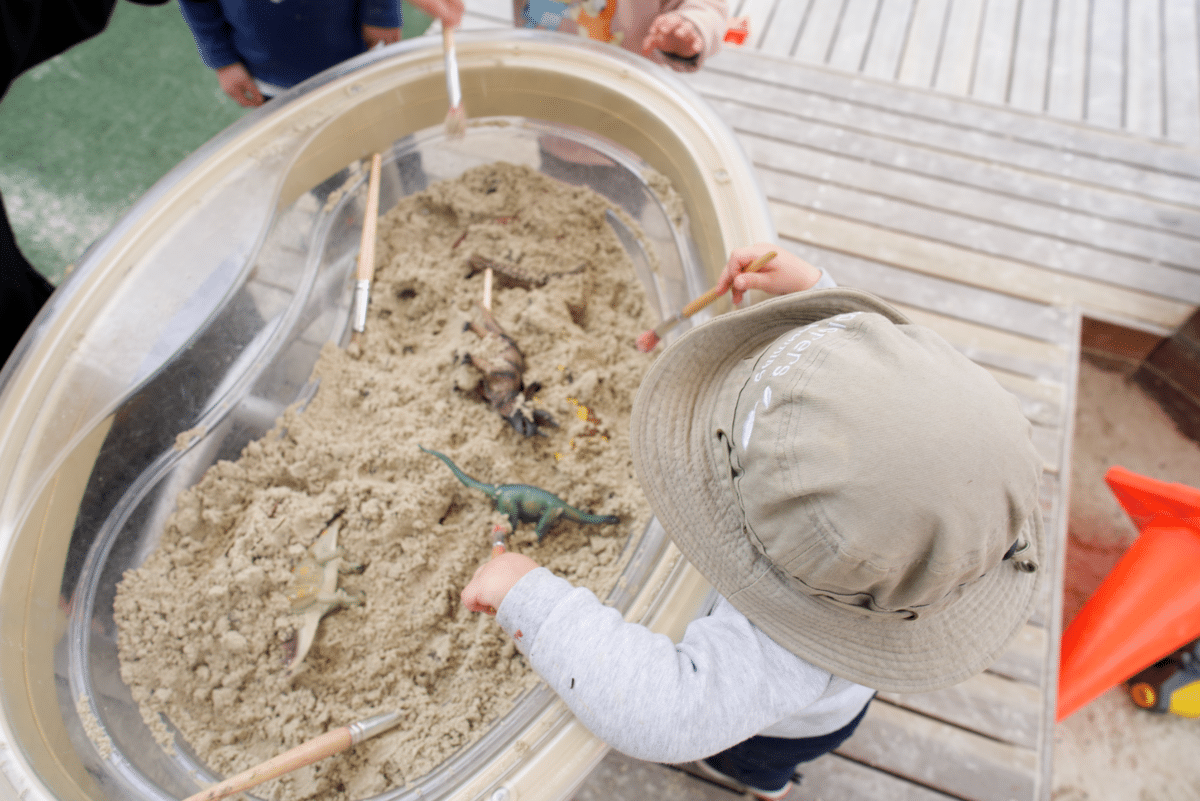
Enhanced Language Development
As children learn about dinosaurs, they’re exposed to an extensive vocabulary related to science, history, and palaeontology. Although they may not understand all of these phrases, just pronouncing them is a phonetic exercise that may lead to a better understanding of written and spoken words.
Learning to pronounce terms like ‘tyrannosaurus rex,’ ‘herbivore’ and ‘fossilisation’ create new neural pathways and stimulate cognition. This exposure to new words and concepts can help them develop language skills, improve communication, and expand vocabulary.
Make New Friends
If your toddler is going through the dinosaur phase, chances are there are many others in their childcare room, kinder, or family friends on the same journey. You can use this shared fascination to organise playdates for your child to make new friends!
In fact, according to the American Academy of Paediatrics, peer play and games are essential to their early development:
Pretend play encourages self-regulation because children must collaborate on the imaginary environment and agree about pretending and conforming to roles, which improves their ability to reason about hypothetical events.

Sparks Creativity and Imagination
By its very nature, the dinosaur phase requires imaginative play. As dinosaurs no longer exist, they naturally encourage creativity and fascination for children. This is likely because of their likeness to fictional creatures such as dragons.
You can use this fascination to encourage all kinds of creative dinosaur activities. They might draw pictures, build models, or flex their dinosaur muscles by pretending to be a humble brontosaurus or a terrifying t-rex. Likewise, this imaginative play develops creativity and encourages abstract thinking.
Puts Time and History into Perspective
At around age 4-5, children begin to understand that the world existed long before they did. Additionally, they learn that our history is fascinating and complex. Therefore, the dinosaur phase perfectly introduces children to this concept in a fun and accessible way.
Children learn about an entirely different world with its own creatures and ecosystem over 66 million years ago – the number itself enough to spark wonder and awe.
It’s sometimes said that palaeontologists are grownups that never grew out of the dinosaur phase. An early fascination with science can lead to careers in archaeology, geology, meteorology, and environmental sciences!
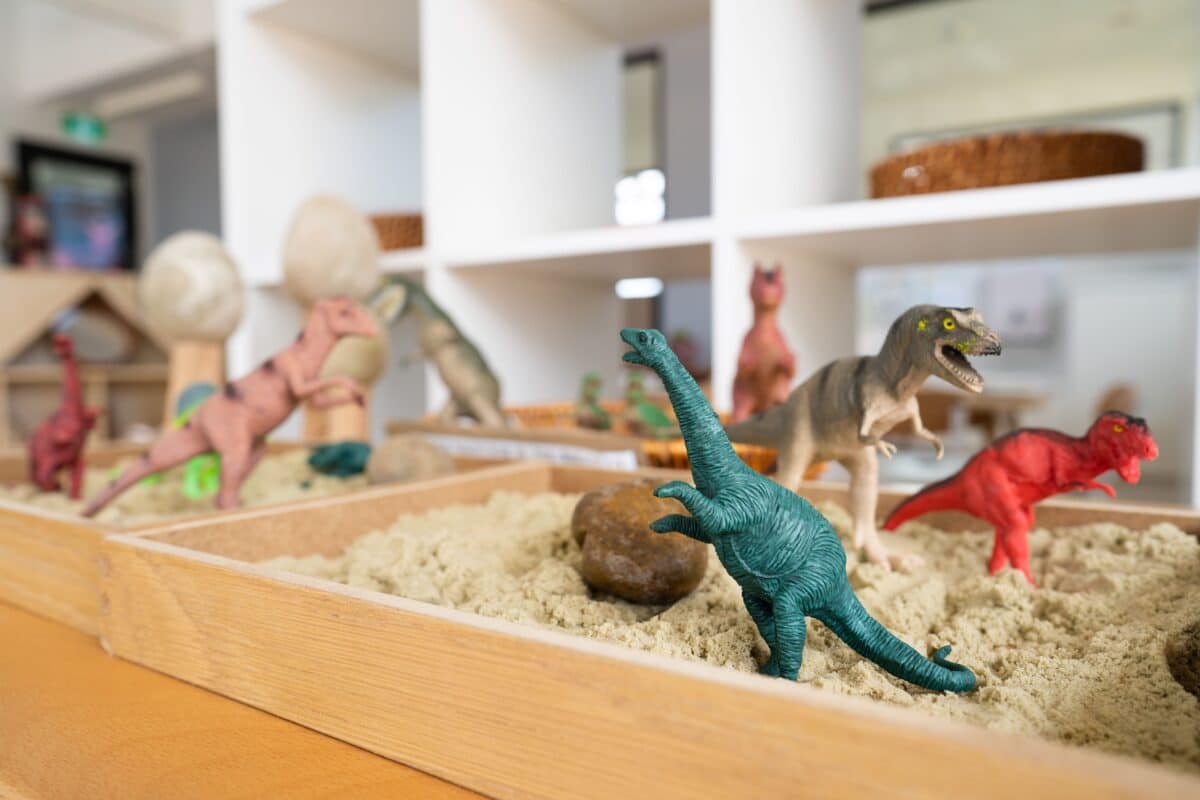
Promotes a Love of Nature and the Environment
As children learn about dinosaurs, they also learn about the environment they lived in and the impact that humans have on the planet today. This can help them develop a sense of responsibility for the natural world and a desire to preserve it.
Overall, the dinosaur phase is so much more than just a passing fad. It’s an opportunity for your child to express their creativity, independence, and foster a lifelong love of science and the natural world. So be sure to encourage their interest in dinosaurs by reading books, visiting museums, and engaging in imaginative play. Who knows, your child might grow up to discover the next dinosaur species.
🍃 To tour one of our beautiful Centres, please click here. Otherwise, check out our website to register your interest at Explorers Early Learning today!
Reggio Emilia and Montessori: What’s the Difference?
Reggio Emilia or Montessori? What do they mean and which is right for your child? Read on for our breakdown of these two popular early education philosophies 👇
Does this sound familiar: you’re researching childcare services and two phrases keep appearing – Reggio Emilia and Montessori. It’s easy to get lost in the wording as they both talk about child-centred curriculums and non-traditional learning.
But what if we told you these early learning approaches differ in some really important ways?
In this post, we break down the Reggio Emilia and Montessori approaches to early childhood education to help you decide which is the perfect fit for your child.
What is the Reggio Emilia Approach?
The Reggio Emilia approach, named after the Italian town where it was founded by Loris Malaguzzi, emphasises project-based learning, creativity, and community involvement.
Reggio Emilia classrooms, often connected by a central piazza for collaboration and discussion, are filled with natural materials, light, and open spaces. Children are seen as active participants in their own learning journey. They co-construct knowledge and spark curiosity alongside their peers and Educators.
The Reggio Emilia approach identifies three teachers in children’s learning:
- The teacher – responsible for constructing and guiding learning experiences. Educators provoke discussion, ask open-ended questions, and explore emerging interests with the children. In other words, they’re co-learners.
- The parent – the home environment is key to building on meaningful learning experiences. Therefore, parents are encouraged to take an active role in emerging interests, projects, and hands-on learning.
- The environment – learning spaces are designed to be aesthetically pleasing, stimulating, and interactive. Artwork, natural materials, and plenty of colour are commonplace in Reggio Emilia classrooms to inspire creativity and imagination.
What is the Montessori Approach?
Developed by Dr. Maria Montessori in the early 1900s, this approach values children’s need to explore, discover, and learn at their own pace.
The Montessori classroom is a carefully prepared environment where children can choose their own activities from a range of self-correcting materials such as puzzles and loose parts. These materials encourage children to problem-solve instinctively and without the need for strict instructions.
Additionally, the Montessori approach features hands-on learning through workshops. These aim to build independence, self-discipline, and practical life skills. Through interactive learning experiences, the Montessori approach encourages self-directed learning, rather than in large groups.
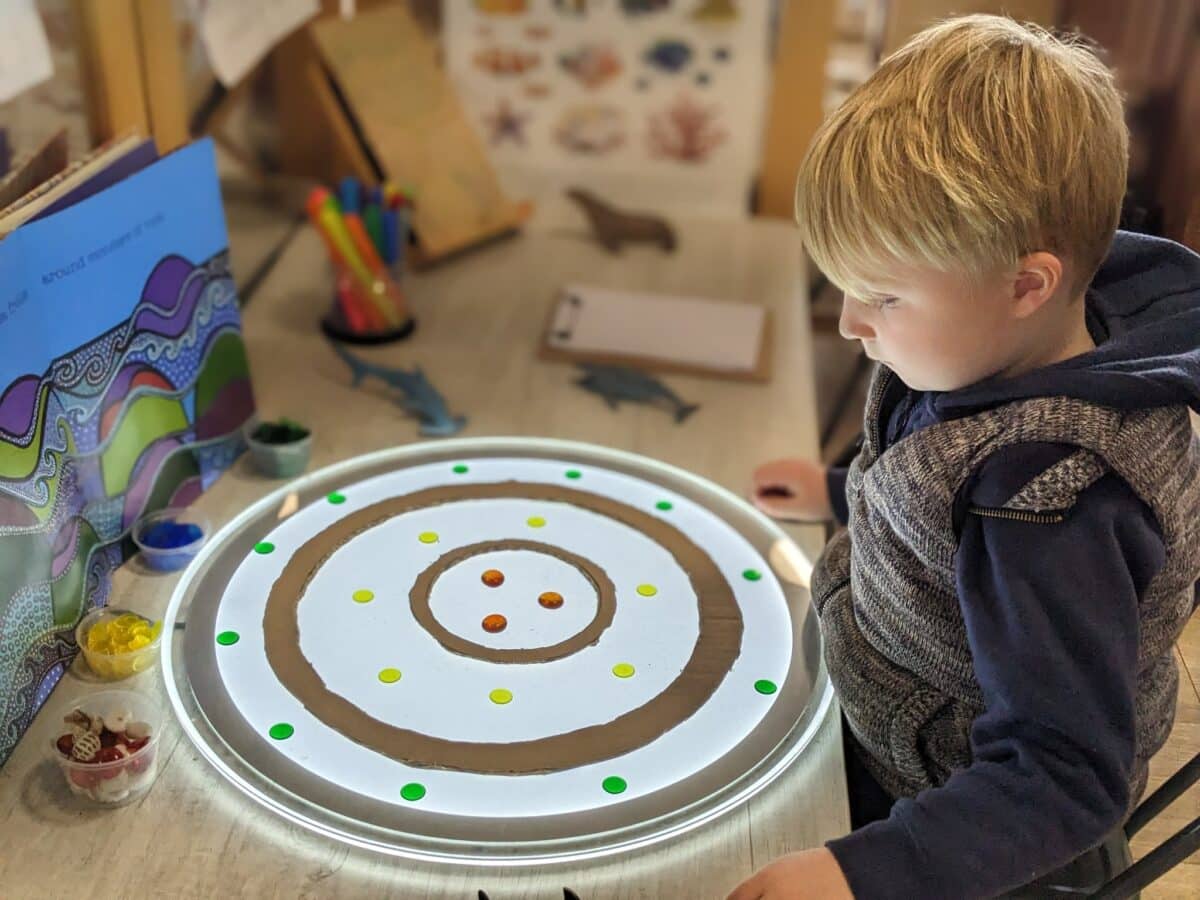
How do Reggio Emilia and Montessori Differ?
While both Montessori and Reggio Emilia value child-centred learning, they’re also different in their approach to curriculum.
Reggio Emilia embraces an emergent curriculum which evolves based on the interests and inquiries of the children. Educators encourage these interests with intentional provocations.
For example, if a child takes an interest in space, and Educator may provide them with different materials to create a star chart. This intentional experience introduces the child to different sensations – the feel of the materials and the sounds they make – while also acting as the foundation for continued learning.
How big is space? What is the Milky Way? How many planets are there in the solar system?
Montessori on the other hand follows a pre-determined curriculum, with specific materials and activities designed to support children’s development across different areas and outcomes.
Moreover, the Montessori curriculum favours observation by teachers, whereas Reggio Educators favour documentation of observations to share with parents and signpost learning milestones.
The Reggio Emilia approach emphasises community and group-based learning, while Montessori values independent and small group learning.
For a full breakdown of the differences, see the table below!
| Montessori | Reggio Emilia | |
| Learning style | Child-centric, non-traditional. | Child-centric, non-traditional |
| Role of the Educator/Teacher | Observer and facilitator of knowledge. | Collaborator and co-learner. Educators guide learning experiences and ask open-ended questions. |
| Method | Learning through play and self-correcting materials alone or in small groups. Strict development stages. | Children work in small groups in project-based learning. Community and parental involvement encouraged. |
| Curriculum | Pre-determined and can be adapted to primary and secondary education. | Fluid curriculum which is adapted to emerging interests and unique learning styles. |
| Focus | Independence. | Independence and collaboration. |
| Evidence collection | Observation. | Observe and document. |
| Goal | To form independent and curious learners. | To nurture children to become lifelong learners and citizens of the world. |
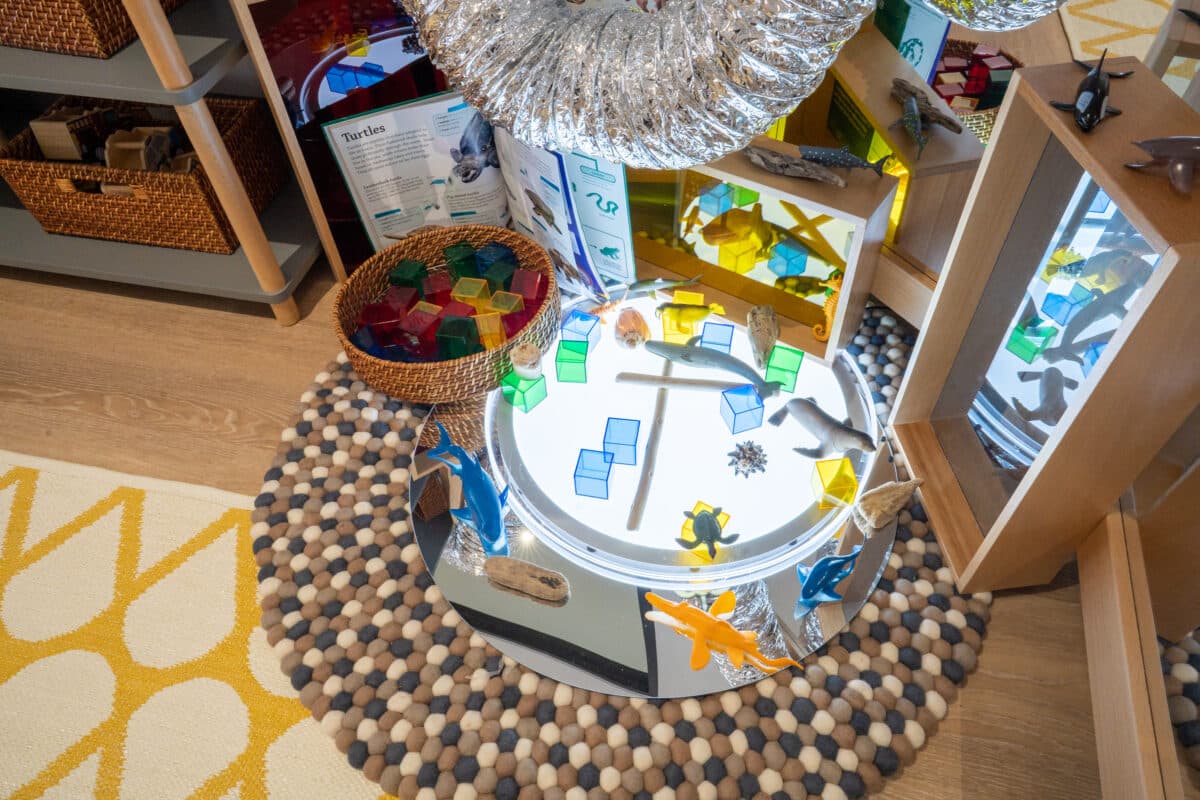
Which Approach is Right for Your Child?
Overall, it’s important to remember that there’s no one-size-fits-all approach to early childhood education. Each child is unique, with their own set of interests, learning styles, and needs. The Montessori approach and the Reggio Emilia approach each offer distinct educational experiences.
While some children may thrive in the Montessori system, others blossom in the collaborative environment of Reggio Emilia. The best way to decide is to visit centres, talk with educators, research widely, and consider all approaches. In other words, trust your intuition to decide which approach resonates with your child’s unique personality and stage of development.
🍃 To tour one of our beautiful Centres, please click here. Otherwise, check out our website to register your interest at Explorers Early Learning today!
What is the Early Years Learning Framework (EYLF)?
Belonging, Being, Becoming – these three words form the foundation of the Early Years Learning Framework (EYLF). Read on for our breakdown of this vital early education resource.
It’s easy to get lost in the sea of early education terminology from government subsidies to the countless regulatory bodies and quality advisors. However, one term you should know about is the Early Learning Years Framework (EYLF).
This comprehensive early education framework extends and enriches early education for children aged from birth to five years.
But as a 70 page Government document, it’s not exactly a quick read. To save you the time, we’ve broken down the EYLF to provide an insight into how it guides our Explorers curriculum from the nursery all the way up to those embarking on their primary school journey.
Creating the EYLF
In 2009, the Department of Education published Belonging, Being & Becoming: The Early Years Learning Framework for Australia (EYLF). While a historic moment as it was Australia’s first national Early Years Learning Framework, it was redeveloped and expanded into a V2.0 in 2022.
This national framework was developed by the Council of Australian Governments to provide a shared understanding of the foundational principles, practices, and outcomes for early childhood education and care in Australia. The EYLF is based on scientific research and empirical evidence to support all children’s education from birth to age five.
Three key principles form the foundation of the EYLF:
- Being: the importance of children’s experiences in the present moment. Children learn through play, exploration, and communication. These experiences are essential to their overall development and can’t be overlooked.
- Belonging: the need for children to feel connected to their family, community, and culture. When children feel a sense of belonging, they’re more likely to feel safe and supported in their educational environment. This principle recognises children as deeply influenced by their social and cultural context.
- Becoming: children are constantly growing and changing. Children aren’t passive recipients of knowledge, but rather active participants in their own learning and development. This principle recognises that children are competent and independent learners – a fundamental concept to the Reggio Emilia approach to early education.

Victorian Early Years Learning Framework (VEYLF)
While the EYLF is a national framework for early childhood education and care, the VEYLF caters for Victorian children specifically. However, it’s still based on the EYLF and its core principles. The VEYLF also includes additional information and guidance on the learning and development of children from birth to eight years of age.
Although both frameworks share similar goals and outcomes, the VEYLF places a greater emphasis on the development of children from birth to three years of age and focuses on cultural diversity, inclusion, and community engagement. Also, the VEYLF provides more specific guidance on how early childhood educators can support children’s learning and development in Victoria’s cultural and social context.
Five Learning Outcomes of the EYLF
The EYLF identifies five learning outcomes for children. These outcomes support children’s development and learning holistically:
- Children have a strong sense of identity.
- Children are connected with and contribute to their world.
- Children have a strong sense of wellbeing.
- Children are confident and involved learners.
- Children are effective communicators.

Explorers and the EYLF
The EYLF outlines a range of experiences and activities designed to support children’s education and growth across the five key outcomes. These experiences and activities are varied and may include music, art, outdoor play, and social interaction.
At Explorers, we embrace the power of experiences and actively embed them into our curriculum through our Enrichment Program. This Program focuses on five key areas:
- Little Impressionists – Art
- Little Linguists – Language
- Active Explorers – Physical Activity
- Prep for Prep – School Readiness
- One World, One Planet – Sustainability
Moreover, we encourage project-based learning as part of our Reggio Emilia inspired curriculum. These projects often take the form of science and the arts to form a comprehensive STEAM (science, technology, engineering, arts and mathematics) learning experience.
Music, for example, helps children expand their language and communication skills, as well as their coordination and rhythm. Likewise, science and numeracy prepare children for their academic journey in primary school, secondary school and beyond.

EYLF and the Importance of Community
Importantly, these activities build meaningful relationships between children, providing valuable lessons they transition into social situations and the household. Likewise, Educators strive to build strong relationships with children and their families. These relationships ensure our Centres remain a safe, secure, and supportive environment in which children thrive.
As outlined in the EYLF, children feel comfortable and confident when valued, respected and exposed to appropriate learning challenges. Educators, therefore, stimulate discovery by identifying and tailoring learning experiences for children’s emerging interests.
Overall, the EYLF provides a comprehensive approach to early childhood education and care. The Framework emphasises the importance of exploration and communication in children’s learning and development. Most of all, it identifies the power of play which is essential to the development of healthy and happy children!
🍃 To tour one of our beautiful Centres, please click here. Otherwise, check out our website to register your interest at Explorers Early Learning today!
Exploring the Reggio Emilia Approach® to Early Childhood Education
You’ve probably heard of it, but what exactly is the Reggio Emilia Approach®? Read on for our breakdown of adult and child-centred early learning philosophy.
The Reggio Emilia Approach® has soared in popularity in recent decades. This approach to early education was created in the town of Reggio Emilia, Italy, and has become renowned worldwide for its focus on the child as an active participant in their learning.
At Explorers, we’re proud to deliver a Reggio Emilia inspired curriculum from our intentional teaching strategies along with the construction of our learning spaces. But what exactly is the Reggio Emilia Approach®?
In this post, we break down the Reggio Emilia Approach® and consider how it challenges traditional early childhood views of children, their experiences, and unique ways of learning.
A Brief History of the Reggio Emilia Approach®
The Reggio Emilia Approach® was developed during the aftermath of WWII by Loris Malaguzzi and the community of Reggio Emilia, Italy.
The philosophy was born out of a desire to create a new kind of education that would instil the values of the region, including democracy, community, and solidarity. Malaguzzi firmly believed that children construct their own knowledge through interactions with their peers, adults, the physical and social environment, materials and resources, and more.
The Environment as the Third Teacher
In the Reggio Emilia Approach®, they refer to the metaphor of the environment as the third teacher. This metaphor suggests that children construct knowledge from many sources and their education is enhanced by a collaborative approach, rather than a passive transmissive approach.
Educators are responsible for constructing a learning environment that encourages exploration, creativity, and critical thinking. The teacher observes and documents children’s learning and uses this information to inform their teaching practice. Therefore, the teacher’s responsibility is to empower children to take an active role in their own learning and to facilitate growth, development, and curiosity.
Families are essential partners in the learning process. They are encouraged to talk to their children to share their knowledge and expertise, and to collaborate with teachers in designing learning experiences and contribute to projects that explore children’s curiosities.
The environment is considered just as important as families or educators in children’s educational journey. Carefully designed learning environments promote exploration, creativity, and learning. Children are active participants in the learning process, and environments are therefore designed to be flexible, adaptable, and responsive to deep underlying pursuits and curiosities of children.

Key Principles of the Reggio Emilia Approach®
A series of principles inform all aspects of a Reggio Emilia-inspired curriculum:
- Children are rich, strong, powerful, competent and capable of constructing their own learning.
- Children learn by watching, listening, and experiencing.
- Children are collaborators and learn through interaction with others.
- Documentation is a strategy used by educators to make children’s learning visible.
- Educators provide rich open-ended environments for children to express themselves.
- Projects are developed for children to research the world around them.
Project-Based Learning
Projects are a core component of the Reggio Emilia Approach®. In other words, children’s emerging curiosities are noted and acted upon. Therefore, our Educators play a vital role in guiding emerging curiosities by asking questions and providing materials to nurture awe, wonder, and learning.
An example of a project could be a child taking an interest in how insects move. An Educator would ask questions, listen to children, and may focus on the concepts of flying or crawling as intentionality for the environments they design for children to explore. The Educator would then observe children, interpret their learning, and document their experiences, always thinking about how to extend children’s learning. They may ask children:
How does an insect move?
Does it have wings or legs?
Where do insects live?
The children’s answers would then be recorded in documentation. Documentation is critical to record the process and progress of the project. It is shared with families to communicate their child’s learning and learning processes.

How does the Reggio Emilia Approach® differ from traditional education philosophy?
The Reggio Emilia Approach® differs from traditional early childhood approaches. Firstly, it places a strong emphasis on the image of the child as an active participant in their own learning rather than a passive recipient of knowledge.
Additionally, it values communication and communication among children, teachers, parents, and the broader community.
Lastly, the the educational principles and values of Reggio Emilia include creativity and imagination and therefore children are offered various media as a means of expression and learning.
The Appeal of Reggio Emilia
There are numerous appealing features to the Reggio Emilia Approach®:
- Children are considered citizens with rights.
- Curriculum design builds on the curiosities of children to ignite awe and wonder.
- The value of the unique abilities of each child promotes a sense of individuality, but also value as a group member.
- Creativity and critical thinking enhances engagement and joy.
Encourages creativity and critical thinking, preparing children for success in the modern world.
What is the Image of the Child?
The Reggio Emilia Approach® places a high value on the image of the child. In other words, children are seen as capable, competent, and full of potential. Therefore, the Educator’s role is to facilitate children’s learning by creating an environment that encourages exploration, creating motivation to learn. Ultimately, children are free to express themselves through various means, such as drawing, painting, and sculpture, just to name a few.
The Reggio Emilia Approach is an innovative approach to early education which emphasises collaboration, communication, and creativity. These values are favoured by many early learning providers and families along with recognising the unique abilities and curiosities of each child. Explorers is inspired by the educational project of Reggio Emilia and commits to providing a curriculum for young children that fosters a love of learning.
🍃 To tour one of our Reggio Emilia inspired Explorers Centres, please click here. Otherwise, check out our website to register your interest at Explorers Early Learning today!